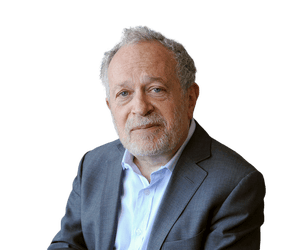UPDATED
Canada police make first arrest as protesters continue to block key bridge to US
Issued on: 13/02/2022 -
Issued on: 13/02/2022 -
Canadian police made the first arrest of a protester blocking a key bridge to the United States on Saturday, more than a day after authorities moved in seeking to end the blockade of the important trade corridor.
A protester stands in front of police officers, who stand guard on a street after Windsor Police said that they are starting to enforce a court order to clear truckers and supporters who have been protesting against coronavirus disease (Covid-19) vaccine mandates by blocking access to the Ambassador Bridge, which connects Detroit and Windsor, Canada on February 12, 2022. © Carlos Osorio, Reuters
‘Freedom Convoy’ protesters, police face off at U.S.-Canada border as Trudeau looks at ‘all options’

Protesters interact with police officers, who stand guard on a street after Windsor Police said that they are starting to enforce a court order to clear truckers and supporters. (REUTERS/Carlos Osorio)
By Annabelle Timsit, Bryan Pietsch and Miriam Berger

Protesters interact with police officers, who stand guard on a street after Windsor Police said that they are starting to enforce a court order to clear truckers and supporters. (REUTERS/Carlos Osorio)
By Annabelle Timsit, Bryan Pietsch and Miriam Berger
Today 7:30 a.m. EST
A standoff between police and protesters from the self-styled “Freedom Convoy” opposing coronavirus vaccine mandates continued Sunday near a vital U.S.-Canada border crossing, even as crowds reportedly started shrinking overnight and one arrest was made. After law enforcement enforced an injunction ordering truckers and their supporters to leave, and ticketed and towed vehicles, a defiant core of protesters mostly remained on foot as temperatures dropped below freezing.
The blockade of the Ambassador Bridge, a key trade corridor that connects Windsor, Ontario, to Detroit, which has disrupted traffic and the flow of goods since Monday, has not ended. Disruptions are still plaguing other vital cross-border arteries — from Coutts, Alberta, which connects to Montana, to Surrey, British Columbia, which connects to Washington state.
Canadian Prime Minister Justin Trudeau has stressed that “all options are on the table” to resolve the crisis, and that “border crossings cannot, and will not, remain closed,” his office said in a statement to the Associated Press.
2:52
Canadian Prime Minister Justin Trudeau on Feb. 11 promised President Biden quick action to end blockades by anti-vaccine mandate protesters at border crossings. (Reuters)
Canada and the United States have denounced the impact of border disruptions on trade, industry and local communities. Goods worth some $360 million — a quarter of the value of all goods traded between the two countries — are transported every day on Ambassador Bridge. Car manufacturers including Toyota and Ford Motor have reduced some of their nearby operations in recent days because they said the blockade disrupted the delivery of necessary manufacturing parts.
In the capital Ottawa, police grappled with an influx of anti-government and anti-vaccine-mandate demonstrators for a third straight weekend despite both local and provincial officials declaring states of emergency. Law enforcement appeared to be floundering in their attempts to get Freedom Convoy protesters to leave by threatening them with fines, prison time, and the loss of their licenses.
Ottawa’s protesters celebrate as officials declare emergencies and threaten fines
The Freedom Convoy — which began in Canada as a denunciation of vaccine mandates for cross-border truckers and has snowballed into a protest of public health measures and politicians — continued to inspire other protests around the world over the weekend.
Across the Atlantic, French protesters temporarily blocked the Champs-Élysées, a central artery in Paris on Saturday, in spite of an order banning them from entering the capital. Local outlets reported that police made at least 97 arrests.
France’s ‘Freedom Convoy’ disrupts traffic on the Champs-Elysees in Paris, confronts police
Farther afield in New Zealand’s capital, protesters inspired by the Freedom Convoy blocked an area outside parliament in Wellington for the sixth day on Sunday — as officials there attempted to use sprinklers and songs like “Baby Shark” to diffuse the protest, to no avail. Police offered to provide alternative parking arrangements for protesters so long as they move their cars and camper vans from blocking the roads.
New Zealand switches on sprinklers, and ‘Baby Shark,’ to deter ‘Freedom Convoy’-inspired protesters
In Canada, as Trudeau and police come under pressure to do more to rein in the raucous protests, some local officials have acknowledged the potentially fraught implications of mass arrests or tougher action. Windsor’s mayor, Drew Dilkens, warned that arresting people could lead to violence, saying during a news briefing last week that some protesters believe “they are fighting for a cause that is worth dying for.”
Trudeau has previously said that using Canada’s military is “not in the cards right now.”
After an Ontario judge ordered the demonstrators to leave the Ambassador Bridge by 7 p.m. Friday, Windsor police tweeted Saturday evening that they were towing and ticketing vehicles there. Some vehicles began moving away from the area, while demonstrators on foot displayed the Canadian flag and sang the country’s national anthem, chanting “Freedom!” periodically. Protesters began dismantling tents at the site and packing up grilling supplies.
A wall of police officers slowly pushed protesters away from the bridge, warning that demonstrators would be arrested if they did not leave. But more people on foot had swelled the protesters’ ranks by early afternoon, with demonstrators appearing to outnumber police officers, according to reporters from the Canadian Broadcasting Corp. News, Canada’s public broadcaster.
Windsor Police said Saturday that a 27-year-old man was arrested “for a criminal offence in relation to the demonstration” at an intersection near the U.S.-Canada border. “Officers will intervene when necessary to ensure the safety of the public & maintain peace & order,” the police tweeted.

 Police officers stand guard in front of a car painted with slogans as it leaves the protest, as truckers and supporters continue blocking access to the Ambassador Bridge, which connects Detroit and Windsor, in protest against coronavirus vaccine mandates, in Ontario, Canada, on February 12, 2022.
Police officers stand guard in front of a car painted with slogans as it leaves the protest, as truckers and supporters continue blocking access to the Ambassador Bridge, which connects Detroit and Windsor, in protest against coronavirus vaccine mandates, in Ontario, Canada, on February 12, 2022.


By Bryan Pietschis a reporter covering breaking news for The Washington Post from its hub in Seoul. He previously covered breaking news for the New York Times in Colorado. Twitter

By Miriam Berger is a staff writer reporting on foreign news for The Washington Post from Washington, D.C. Before joining The Post in 2019 she was based in Jerusalem and Cairo and freelance reported around the Middle East, as well as parts of Africa and Central Asia. Twitter
A standoff between police and protesters from the self-styled “Freedom Convoy” opposing coronavirus vaccine mandates continued Sunday near a vital U.S.-Canada border crossing, even as crowds reportedly started shrinking overnight and one arrest was made. After law enforcement enforced an injunction ordering truckers and their supporters to leave, and ticketed and towed vehicles, a defiant core of protesters mostly remained on foot as temperatures dropped below freezing.
The blockade of the Ambassador Bridge, a key trade corridor that connects Windsor, Ontario, to Detroit, which has disrupted traffic and the flow of goods since Monday, has not ended. Disruptions are still plaguing other vital cross-border arteries — from Coutts, Alberta, which connects to Montana, to Surrey, British Columbia, which connects to Washington state.
Canadian Prime Minister Justin Trudeau has stressed that “all options are on the table” to resolve the crisis, and that “border crossings cannot, and will not, remain closed,” his office said in a statement to the Associated Press.
2:52
Canadian Prime Minister Justin Trudeau on Feb. 11 promised President Biden quick action to end blockades by anti-vaccine mandate protesters at border crossings. (Reuters)
Canada and the United States have denounced the impact of border disruptions on trade, industry and local communities. Goods worth some $360 million — a quarter of the value of all goods traded between the two countries — are transported every day on Ambassador Bridge. Car manufacturers including Toyota and Ford Motor have reduced some of their nearby operations in recent days because they said the blockade disrupted the delivery of necessary manufacturing parts.
In the capital Ottawa, police grappled with an influx of anti-government and anti-vaccine-mandate demonstrators for a third straight weekend despite both local and provincial officials declaring states of emergency. Law enforcement appeared to be floundering in their attempts to get Freedom Convoy protesters to leave by threatening them with fines, prison time, and the loss of their licenses.
Ottawa’s protesters celebrate as officials declare emergencies and threaten fines
The Freedom Convoy — which began in Canada as a denunciation of vaccine mandates for cross-border truckers and has snowballed into a protest of public health measures and politicians — continued to inspire other protests around the world over the weekend.
Across the Atlantic, French protesters temporarily blocked the Champs-Élysées, a central artery in Paris on Saturday, in spite of an order banning them from entering the capital. Local outlets reported that police made at least 97 arrests.
France’s ‘Freedom Convoy’ disrupts traffic on the Champs-Elysees in Paris, confronts police
Farther afield in New Zealand’s capital, protesters inspired by the Freedom Convoy blocked an area outside parliament in Wellington for the sixth day on Sunday — as officials there attempted to use sprinklers and songs like “Baby Shark” to diffuse the protest, to no avail. Police offered to provide alternative parking arrangements for protesters so long as they move their cars and camper vans from blocking the roads.
New Zealand switches on sprinklers, and ‘Baby Shark,’ to deter ‘Freedom Convoy’-inspired protesters
In Canada, as Trudeau and police come under pressure to do more to rein in the raucous protests, some local officials have acknowledged the potentially fraught implications of mass arrests or tougher action. Windsor’s mayor, Drew Dilkens, warned that arresting people could lead to violence, saying during a news briefing last week that some protesters believe “they are fighting for a cause that is worth dying for.”
Trudeau has previously said that using Canada’s military is “not in the cards right now.”
After an Ontario judge ordered the demonstrators to leave the Ambassador Bridge by 7 p.m. Friday, Windsor police tweeted Saturday evening that they were towing and ticketing vehicles there. Some vehicles began moving away from the area, while demonstrators on foot displayed the Canadian flag and sang the country’s national anthem, chanting “Freedom!” periodically. Protesters began dismantling tents at the site and packing up grilling supplies.
A wall of police officers slowly pushed protesters away from the bridge, warning that demonstrators would be arrested if they did not leave. But more people on foot had swelled the protesters’ ranks by early afternoon, with demonstrators appearing to outnumber police officers, according to reporters from the Canadian Broadcasting Corp. News, Canada’s public broadcaster.
Windsor Police said Saturday that a 27-year-old man was arrested “for a criminal offence in relation to the demonstration” at an intersection near the U.S.-Canada border. “Officers will intervene when necessary to ensure the safety of the public & maintain peace & order,” the police tweeted.

(Carlos Osorio/Reuters)
The Royal Canadian Mounted Police in Surrey, British Columbia, southeast of Vancouver, said Saturday night that there was still “significant traffic congestion” on the main road leading to the Pacific Highway Border Crossing into Blaine, Wash. The crowd was “beginning to dissipate” but there were “still a number of individuals on foot,” the police said. An incident involving “a few vehicles” crossing police barricades and driving the wrong way down a street was under investigation, the police said, noting there were no injuries.
In Nova Scotia, protesters on Saturday blocked the Marine Atlantic terminal in North Sydney — the launch point for important ferry routes to Canada’s easternmost provinces. Demonstrations also have targeted border crossings in Manitoba and Alberta, as well as Sarnia in Ontario.
Police, ‘Freedom Convoy’ protesters at stalemate near Ontario border bridge
Ontario Premier Doug Ford called the blockade a “siege” and declared a provincial state of emergency Friday, warning protesters of “severe” consequences, including fines up to $78,500 and prison terms.
In Ottawa, in continued defiance of the state of emergency, loud dance parties raged throughout the blockaded streets. As police on foot and in cars stood watch, convoys of trucks blared their horns, in-spite of anti-noise ordinances in place, and fireworks were illegally set off in crowds. Some people openly drank cans and bottles of alcohol, another violation of Ottawa law.

 Demonstrators dance during a protest by truck drivers over pandemic health rules and the Trudeau government, outside the parliament of Canada in Ottawa on February 12, 2022. (Ed JONES / AFP) (Ed Jones/AFP via Getty Images)
Demonstrators dance during a protest by truck drivers over pandemic health rules and the Trudeau government, outside the parliament of Canada in Ottawa on February 12, 2022. (Ed JONES / AFP) (Ed Jones/AFP via Getty Images)
Families with children, some just in for the day from French-speaking Quebec, mingled among the noise and fuel fumes. People marched through the street shouting “freedom” — in this environment, a catchphrase for doing whatever they wanted without personal consequence.
Hundreds of people joined a counterprotest Saturday afternoon in Ottawa, marching and chanting “Whose streets? Our streets!” and “Hey hey, ho ho, this trucker convoy has got to go!”
Meanwhile in Edmonton, the capital of Alberta province, police issued 10 tickets and said they would issue 60 more by mail as demonstrators in trucks and on foot made their way to a federal building in the city’s downtown. Some reportedly honked their horns, in defiance of a temporary injunction preventing unnecessary noise, and the police said nine of the tickets were related to noise.
Counterprotestors briefly blocked the convoy on a road leading to the Alberta Legislature, local media reported.
The Royal Canadian Mounted Police in Surrey, British Columbia, southeast of Vancouver, said Saturday night that there was still “significant traffic congestion” on the main road leading to the Pacific Highway Border Crossing into Blaine, Wash. The crowd was “beginning to dissipate” but there were “still a number of individuals on foot,” the police said. An incident involving “a few vehicles” crossing police barricades and driving the wrong way down a street was under investigation, the police said, noting there were no injuries.
In Nova Scotia, protesters on Saturday blocked the Marine Atlantic terminal in North Sydney — the launch point for important ferry routes to Canada’s easternmost provinces. Demonstrations also have targeted border crossings in Manitoba and Alberta, as well as Sarnia in Ontario.
Police, ‘Freedom Convoy’ protesters at stalemate near Ontario border bridge
Ontario Premier Doug Ford called the blockade a “siege” and declared a provincial state of emergency Friday, warning protesters of “severe” consequences, including fines up to $78,500 and prison terms.
In Ottawa, in continued defiance of the state of emergency, loud dance parties raged throughout the blockaded streets. As police on foot and in cars stood watch, convoys of trucks blared their horns, in-spite of anti-noise ordinances in place, and fireworks were illegally set off in crowds. Some people openly drank cans and bottles of alcohol, another violation of Ottawa law.

Families with children, some just in for the day from French-speaking Quebec, mingled among the noise and fuel fumes. People marched through the street shouting “freedom” — in this environment, a catchphrase for doing whatever they wanted without personal consequence.
Hundreds of people joined a counterprotest Saturday afternoon in Ottawa, marching and chanting “Whose streets? Our streets!” and “Hey hey, ho ho, this trucker convoy has got to go!”
Meanwhile in Edmonton, the capital of Alberta province, police issued 10 tickets and said they would issue 60 more by mail as demonstrators in trucks and on foot made their way to a federal building in the city’s downtown. Some reportedly honked their horns, in defiance of a temporary injunction preventing unnecessary noise, and the police said nine of the tickets were related to noise.
Counterprotestors briefly blocked the convoy on a road leading to the Alberta Legislature, local media reported.
People keep warm beside a fire during a protest by truck drivers over pandemic health rules and the Trudeau government, outside the parliament of Canada in Ottawa on February 12, 2022.
(Ed JONES / AFP) (Ed Jones/AFP via Getty Images)
— Amanda Coletta in Canada, Meryl Kornfield and Claire Parker contributed to this report.
Read more:
Why are ‘Freedom Convoy’ truckers protesting in Ottawa? Our reporters answered your questions.
Canadian officials caution against ‘foreign interference’ as U.S. Republicans back ‘Freedom Convoy’ protests
Here’s what you need to know about the ‘Freedom Convoy’ in Canada‘
By Annabelle Timsit is a breaking news reporter for The Washington Post's London hub, covering news as it unfolds in the United States and around the world during the early morning hours in Washington. Twitter
— Amanda Coletta in Canada, Meryl Kornfield and Claire Parker contributed to this report.
Read more:
Why are ‘Freedom Convoy’ truckers protesting in Ottawa? Our reporters answered your questions.
Canadian officials caution against ‘foreign interference’ as U.S. Republicans back ‘Freedom Convoy’ protests
Here’s what you need to know about the ‘Freedom Convoy’ in Canada‘
By Annabelle Timsit is a breaking news reporter for The Washington Post's London hub, covering news as it unfolds in the United States and around the world during the early morning hours in Washington. Twitter

By Bryan Pietschis a reporter covering breaking news for The Washington Post from its hub in Seoul. He previously covered breaking news for the New York Times in Colorado. Twitter

By Miriam Berger is a staff writer reporting on foreign news for The Washington Post from Washington, D.C. Before joining The Post in 2019 she was based in Jerusalem and Cairo and freelance reported around the Middle East, as well as parts of Africa and Central Asia. Twitter
A key border crossing between the US and Canada remains impeded after police moved to clear protesters. Now officials are planning their next steps
By Aya Elamroussi, CNN
Updated 5:52 AM ET, Sun February 13, 2022
(CNN)A major border crossing between Canada and the US remained partially impeded Sunday morning despite police efforts to end a blockade by Canadian protesters who oppose Covid-19 mitigation measures in the country as officials prepare for the possibility of more demonstrations elsewhere.
Canadian police moved Saturday to clear protesters from the Ambassador Bridge, which spans the border between Detroit and Windsor, Ontario, following a nearly week-long blockade that snarled traffic and slowed supply chains in both countries.
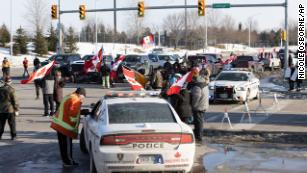
Protesters seemed undeterred at critical bridge to US hours past a deadline set by a Canadian judge
But Canada-bound traffic at the busiest border crossing in North America was still suspended early Sunday, according to a Canadian website that tracks traffic at border crossings. US-bound traffic was open, according to the US Customs and Border Protection website.
A judge had ordered the demonstrators to leave the Ambassador Bridge by 7 p.m. Friday, and some protesters moved away on their own as police approached Saturday morning.
Some pedestrians remained near an intersection on a road leading to the bridge later Saturday, including some talking to or yelling at a line of standing police officers. Others sang the Canadian national anthem or shouted, "Freedom!"
A 27-year-old man was arrested "for a criminal offence in relation to the demonstration," Windsor Police said Saturday, without providing further details.
The protests in Canada began more than two weeks ago when truckers converged on the capital city of Ottawa to demonstrate their opposition to a new rule requiring them to be fully vaccinated against Covid-19 or face quarantine in their homes for two weeks when they return to Canada after crossing the US border.
Since then, protests have expanded into several different cities and border crossing with people voicing their opposition to Canada's Covid-19 mitigation measures, including restrictions on gatherings and mask mandates.
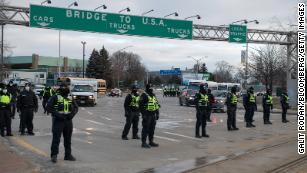
Why the Ambassador Bridge is crucial to two nations' economies
Canada has one of the highest vaccination rates in the world, with about 4 in every 5 Canadians fully vaccinated, according to data from Johns Hopkins University. And nearly 90% of the country's truckers are fully vaccinated and eligible to cross the border, according to the Canadian government.
Still, the protesters have been vocal and used their truck horns to express their opposition, prompting a judge in Ottawa to rule Monday that they must stop honking for 10 days.
Protesters have also used semitrailers -- and sometimes farm equipment and other vehicles -- to block crossings between Emerson, Manitoba, and Pembina, North Dakota, as well as at the Coutts access point between Alberta and Montana.
And about 50 vehicles have blocked access to the Canadian-US border at Emerson since Thursday, the Manitoba Royal Canadian Mounted Police said Saturday.
The blockade has alarmed political leaders, including in the US.
"We are at an economic crisis because of this illegal blockade," which is becoming a homeland security issue, Michigan Gov. Gretchen Whitmer told CNN Friday.
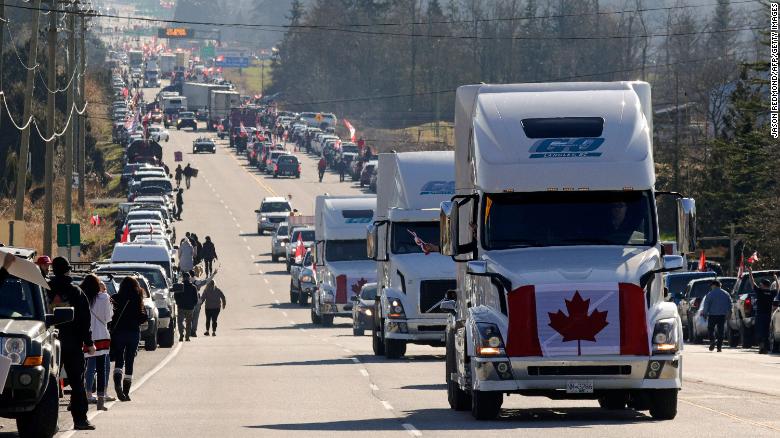
Trucks displaying the Canadian national flag drive by as anti-vaccine mandate and anti-government protesters demonstrate on February 12 on Highway 15 near the Pacific Highway Border Crossing on the US-Canada border with Washington State in Surrey, British Columbia, Canada.
Canadian officials discuss additional response
Canadian Prime Minister Justin Trudeau and other government officials were briefed on the law enforcement action in Windsor Saturday, a statement from his office said.
"The Prime Minister stressed that border crossings cannot, and will not, remain closed, and that all options remain on the table," the statement said.
The ministers also discussed "further immediate actions the federal government is considering" and will meet again Sunday.
Additionally, the statement said the Ontario Provincial Police, the Royal Canadian Mounted Police and the Ottawa Police Service established an Integrated Command Centre (ICC) to address the escalating tensions in Ottawa, where more than 4,000 demonstrators were present throughout Saturday, police said in a news release.
"Safety concerns - arising from aggressive, illegal behaviour by many demonstrators - limited police enforcement capabilities," the Ottawa Police Service said. "We expect that the ICC will result in a significantly enhanced ability of our police service to respond to the current situation in our city."
Ottawa Mayor Jim Watson told CNN that he expected even more protests as the weekend unfolds.
"It's completely unacceptable," Watson said. "Particularly in the neighborhoods where some of the protesters are going into restaurants and refusing to wear a mask and harassing staff and really being belligerent to the residents of our city."
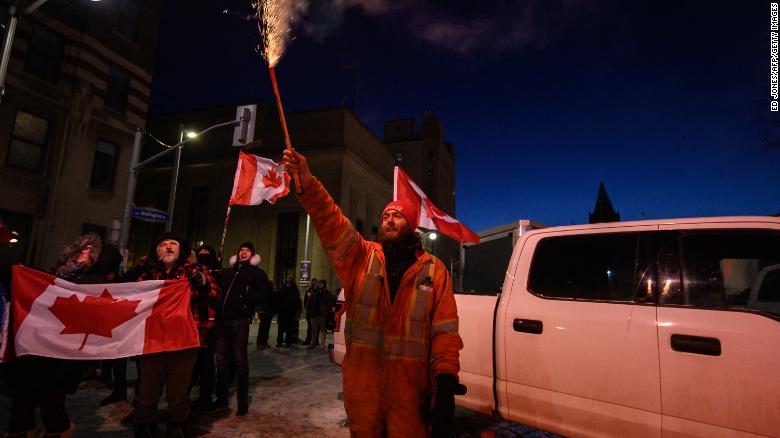
A demonstrator lets off fireworks during a protest by truck drivers over pandemic health rules and the Trudeau government, outside the parliament of Canada in Ottawa on February 12.
Officials in US 'ready' if similar protests break out
Meanwhile in the US, officials are gearing up to potentially face similar protests, including one possibly affecting Super Bowl in southern California Sunday.
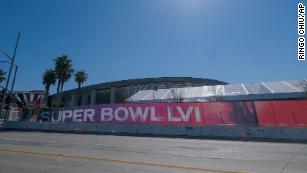
DHS bulletin warns trucker convoy could disrupt Super Bowl Sunday
"The convoy will potentially begin in California as early as mid-February and arrive in Washington, DC, as late as mid-March, potentially impacting the Super Bowl LVI scheduled for 13 February and the State of the Union Address scheduled for 1 March," a bulletin from the Department of Homeland Security said.
In addition, a group in the US said it is organizing two trucker convoys that will head to the US-Canadian border in Buffalo, New York, this weekend.
However, the city said Friday no group had not applied for permits to hold events.
"Nor have the organizers contacted our Special Events Office to arrange for the appropriate insurance and public safety planning that is required for all events in the City to ensure the health and safety of residents and visitors," Buffalo city spokesperson Michael DeGeorge told CNN. "It is always a concern when laws that are designed to keep people and property protected are willfully ignored."
"We're ready for these trucks, but our goal is to keep our roadways open and to make sure that residents and visitors are safe and healthy," Buffalo Mayor Byron Brown told CNN Saturday.
CNN's Ray Sanchez, Miguel Marquez and Kim Berryman reported from Windsor. Paula Newton, Paradise Afshar, Chris Isidore, Lucy Kafanov and Geneva Sands contributed to this report.
By Aya Elamroussi, CNN
Updated 5:52 AM ET, Sun February 13, 2022
(CNN)A major border crossing between Canada and the US remained partially impeded Sunday morning despite police efforts to end a blockade by Canadian protesters who oppose Covid-19 mitigation measures in the country as officials prepare for the possibility of more demonstrations elsewhere.
Canadian police moved Saturday to clear protesters from the Ambassador Bridge, which spans the border between Detroit and Windsor, Ontario, following a nearly week-long blockade that snarled traffic and slowed supply chains in both countries.

Protesters seemed undeterred at critical bridge to US hours past a deadline set by a Canadian judge
But Canada-bound traffic at the busiest border crossing in North America was still suspended early Sunday, according to a Canadian website that tracks traffic at border crossings. US-bound traffic was open, according to the US Customs and Border Protection website.
A judge had ordered the demonstrators to leave the Ambassador Bridge by 7 p.m. Friday, and some protesters moved away on their own as police approached Saturday morning.
Some pedestrians remained near an intersection on a road leading to the bridge later Saturday, including some talking to or yelling at a line of standing police officers. Others sang the Canadian national anthem or shouted, "Freedom!"
A 27-year-old man was arrested "for a criminal offence in relation to the demonstration," Windsor Police said Saturday, without providing further details.
"Officers will intervene when necessary to ensure the safety of the public & maintain peace & order," police said on Twitter.
The protests in Canada began more than two weeks ago when truckers converged on the capital city of Ottawa to demonstrate their opposition to a new rule requiring them to be fully vaccinated against Covid-19 or face quarantine in their homes for two weeks when they return to Canada after crossing the US border.
Since then, protests have expanded into several different cities and border crossing with people voicing their opposition to Canada's Covid-19 mitigation measures, including restrictions on gatherings and mask mandates.

Why the Ambassador Bridge is crucial to two nations' economies
Canada has one of the highest vaccination rates in the world, with about 4 in every 5 Canadians fully vaccinated, according to data from Johns Hopkins University. And nearly 90% of the country's truckers are fully vaccinated and eligible to cross the border, according to the Canadian government.
Still, the protesters have been vocal and used their truck horns to express their opposition, prompting a judge in Ottawa to rule Monday that they must stop honking for 10 days.
Protesters have also used semitrailers -- and sometimes farm equipment and other vehicles -- to block crossings between Emerson, Manitoba, and Pembina, North Dakota, as well as at the Coutts access point between Alberta and Montana.
And about 50 vehicles have blocked access to the Canadian-US border at Emerson since Thursday, the Manitoba Royal Canadian Mounted Police said Saturday.
The blockade has alarmed political leaders, including in the US.
"We are at an economic crisis because of this illegal blockade," which is becoming a homeland security issue, Michigan Gov. Gretchen Whitmer told CNN Friday.

Trucks displaying the Canadian national flag drive by as anti-vaccine mandate and anti-government protesters demonstrate on February 12 on Highway 15 near the Pacific Highway Border Crossing on the US-Canada border with Washington State in Surrey, British Columbia, Canada.
Canadian officials discuss additional response
Canadian Prime Minister Justin Trudeau and other government officials were briefed on the law enforcement action in Windsor Saturday, a statement from his office said.
"The Prime Minister stressed that border crossings cannot, and will not, remain closed, and that all options remain on the table," the statement said.
The ministers also discussed "further immediate actions the federal government is considering" and will meet again Sunday.
Additionally, the statement said the Ontario Provincial Police, the Royal Canadian Mounted Police and the Ottawa Police Service established an Integrated Command Centre (ICC) to address the escalating tensions in Ottawa, where more than 4,000 demonstrators were present throughout Saturday, police said in a news release.
"Safety concerns - arising from aggressive, illegal behaviour by many demonstrators - limited police enforcement capabilities," the Ottawa Police Service said. "We expect that the ICC will result in a significantly enhanced ability of our police service to respond to the current situation in our city."
Ottawa Mayor Jim Watson told CNN that he expected even more protests as the weekend unfolds.
"It's completely unacceptable," Watson said. "Particularly in the neighborhoods where some of the protesters are going into restaurants and refusing to wear a mask and harassing staff and really being belligerent to the residents of our city."

A demonstrator lets off fireworks during a protest by truck drivers over pandemic health rules and the Trudeau government, outside the parliament of Canada in Ottawa on February 12.
Officials in US 'ready' if similar protests break out
Meanwhile in the US, officials are gearing up to potentially face similar protests, including one possibly affecting Super Bowl in southern California Sunday.

DHS bulletin warns trucker convoy could disrupt Super Bowl Sunday
"The convoy will potentially begin in California as early as mid-February and arrive in Washington, DC, as late as mid-March, potentially impacting the Super Bowl LVI scheduled for 13 February and the State of the Union Address scheduled for 1 March," a bulletin from the Department of Homeland Security said.
In addition, a group in the US said it is organizing two trucker convoys that will head to the US-Canadian border in Buffalo, New York, this weekend.
However, the city said Friday no group had not applied for permits to hold events.
"Nor have the organizers contacted our Special Events Office to arrange for the appropriate insurance and public safety planning that is required for all events in the City to ensure the health and safety of residents and visitors," Buffalo city spokesperson Michael DeGeorge told CNN. "It is always a concern when laws that are designed to keep people and property protected are willfully ignored."
"We're ready for these trucks, but our goal is to keep our roadways open and to make sure that residents and visitors are safe and healthy," Buffalo Mayor Byron Brown told CNN Saturday.
CNN's Ray Sanchez, Miguel Marquez and Kim Berryman reported from Windsor. Paula Newton, Paradise Afshar, Chris Isidore, Lucy Kafanov and Geneva Sands contributed to this report.
In Pictures
Gallery
Photos: Protests in Ottawa swell as US border blockades continue
US-Canada border bridge access remains blocked as other demonstrations ramped up in cities across Canada.
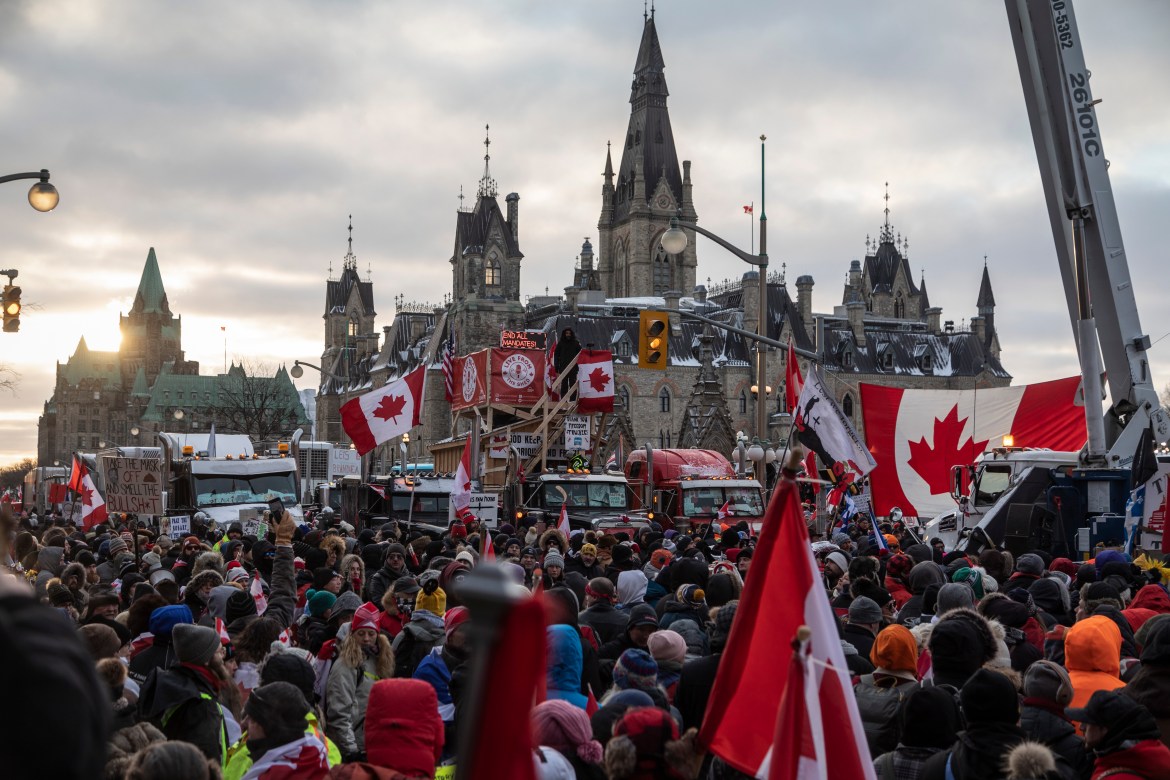
Published On 13 Feb 2022
Protesters opposed to COVID-19 vaccine mandates and other restrictions have withdrawn their vehicles from a key US-Canada border bridge, though access remained blocked, while other demonstrations continued in cities across Canada.
The tense standoff at the Ambassador Bridge linking Detroit in the United States with Windsor, Ontario, eased somewhat early on Saturday when Canadian police persuaded demonstrators to move the trucks they had used to barricade the entrance to the busy international crossing.
But protesters reconvened nearby to choke off access from the Canadian side late on Saturday, snarling traffic and commerce for a sixth day – about 180 remained late Saturday in the sub-freezing cold.
In the capital, Ottawa, police said they were awaiting more officers before ending what they described as an illegal occupation.
The ranks of protesters swelled to what police estimated was 4,000 demonstrators. The city has seen that on past weekends, and loud music played as people milled about downtown where anti-vaccine demonstrators have been encamped since late January.
The protests have reverberated outside the country, with similarly inspired convoys in France, New Zealand and the Netherlands. In the US, the Department of Homeland Security warned that truck convoys may be in the works there.
Ottawa Mayor Jim Watson declared a state of emergency last week for the capital, where hundreds of trucks remained in front of the Parliament Buildings and demonstrators have set up portable toilets outside the prime minister’s office where Justin Trudeau’s motorcade usually parks.

Gallery
Photos: Protests in Ottawa swell as US border blockades continue
US-Canada border bridge access remains blocked as other demonstrations ramped up in cities across Canada.

Protesters massed on Wellington street in front of the Canadian Parliament Buildings for the third weekend in a row. [Roger Lemoyne/Al Jazeera]
Published On 13 Feb 2022
Protesters opposed to COVID-19 vaccine mandates and other restrictions have withdrawn their vehicles from a key US-Canada border bridge, though access remained blocked, while other demonstrations continued in cities across Canada.
The tense standoff at the Ambassador Bridge linking Detroit in the United States with Windsor, Ontario, eased somewhat early on Saturday when Canadian police persuaded demonstrators to move the trucks they had used to barricade the entrance to the busy international crossing.
But protesters reconvened nearby to choke off access from the Canadian side late on Saturday, snarling traffic and commerce for a sixth day – about 180 remained late Saturday in the sub-freezing cold.
In the capital, Ottawa, police said they were awaiting more officers before ending what they described as an illegal occupation.
The ranks of protesters swelled to what police estimated was 4,000 demonstrators. The city has seen that on past weekends, and loud music played as people milled about downtown where anti-vaccine demonstrators have been encamped since late January.
The protests have reverberated outside the country, with similarly inspired convoys in France, New Zealand and the Netherlands. In the US, the Department of Homeland Security warned that truck convoys may be in the works there.
Ottawa Mayor Jim Watson declared a state of emergency last week for the capital, where hundreds of trucks remained in front of the Parliament Buildings and demonstrators have set up portable toilets outside the prime minister’s office where Justin Trudeau’s motorcade usually parks.

Ottawa Mayor Jim Watson declared a state of emergency last week for the capital, where hundreds of trucks remained in front of the Parliament Buildings. [Roger Lemoyne/Al Jazeera]
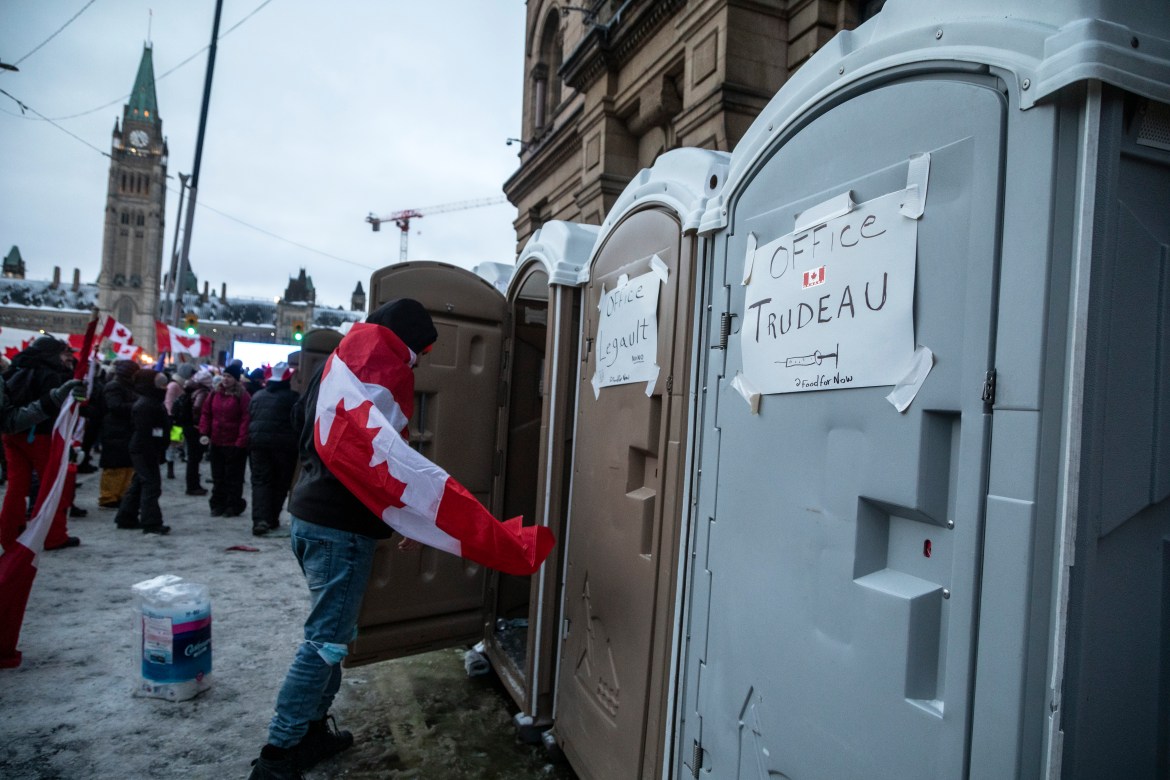 Demonstrators have set up portable toilets outside the prime minister’s office where Trudeau’s motorcade usually parks. [Roger Lemoyne/Al Jazeera]
Demonstrators have set up portable toilets outside the prime minister’s office where Trudeau’s motorcade usually parks. [Roger Lemoyne/Al Jazeera]
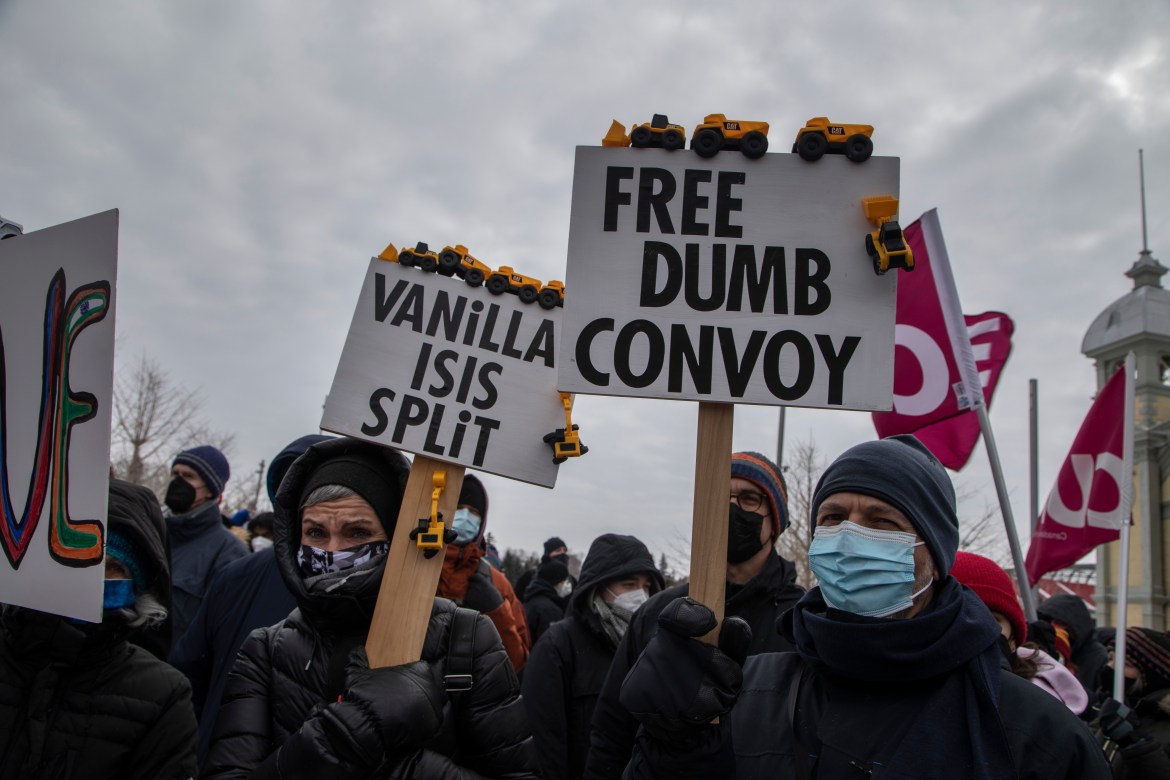
 Demonstrators have set up portable toilets outside the prime minister’s office where Trudeau’s motorcade usually parks. [Roger Lemoyne/Al Jazeera]
Demonstrators have set up portable toilets outside the prime minister’s office where Trudeau’s motorcade usually parks. [Roger Lemoyne/Al Jazeera]
A counterprotest was held starting in Lansdowne Park. [Roger Lemoyne/Al Jazeera]


Less than 2,000 people joined the counterprotests. [Roger Lemoyne/Al Jazeera]
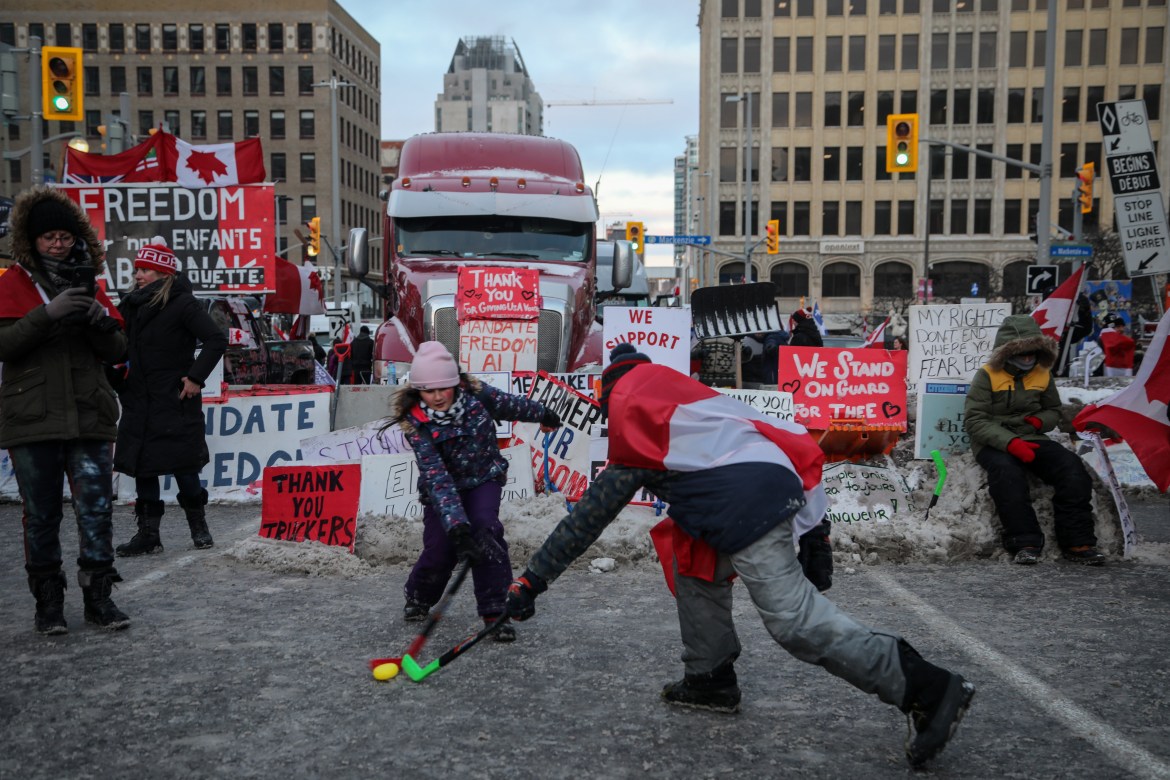

While the protesters are decrying vaccine mandates for truckers and other COVID-19 restrictions, many of Canada's public health measures, such as mask rules and vaccine passports for getting into restaurants and theaters, are already falling away as the Omicron surge levels off. [Roger Lemoyne/Al Jazeera]
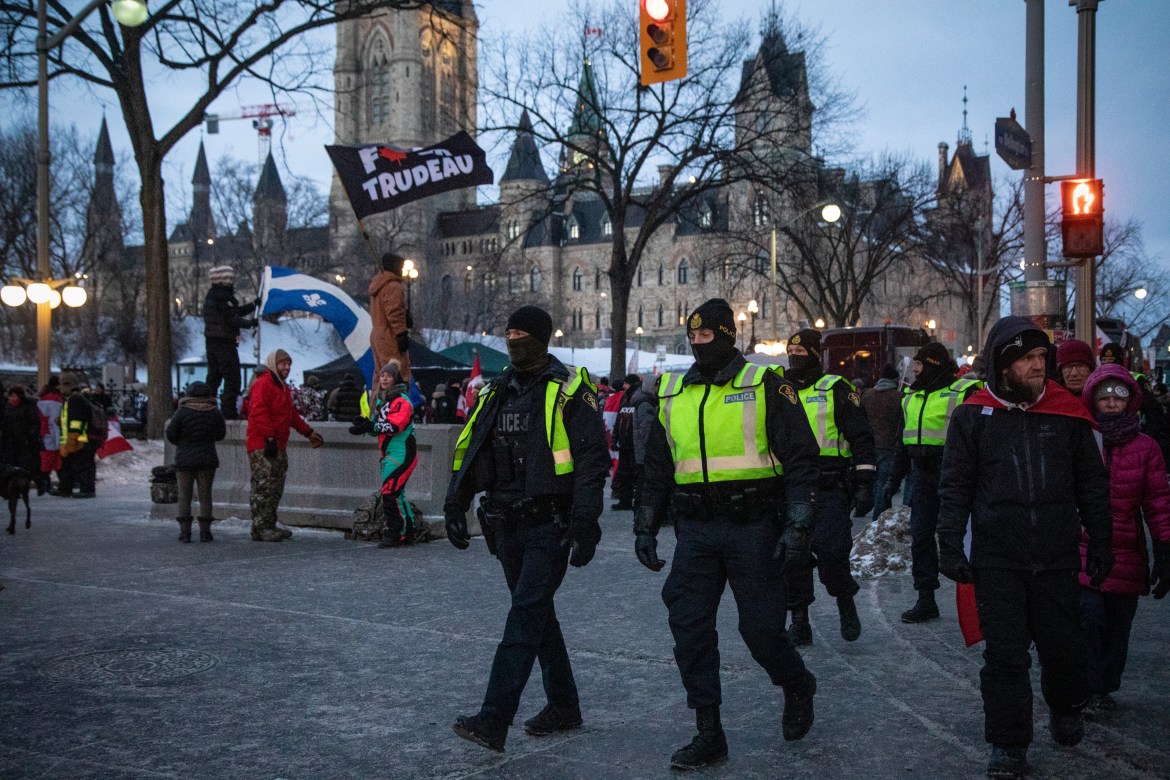

Multiple municipal police forces as well as the Ontario Provincial Police and the RCMP have been deployed in Ottawa. Police issued a statement calling the protest an unlawful occupation and saying they were waiting for police “reinforcements” before implementing a plan. [Roger Lemoyne/Al Jazeera]
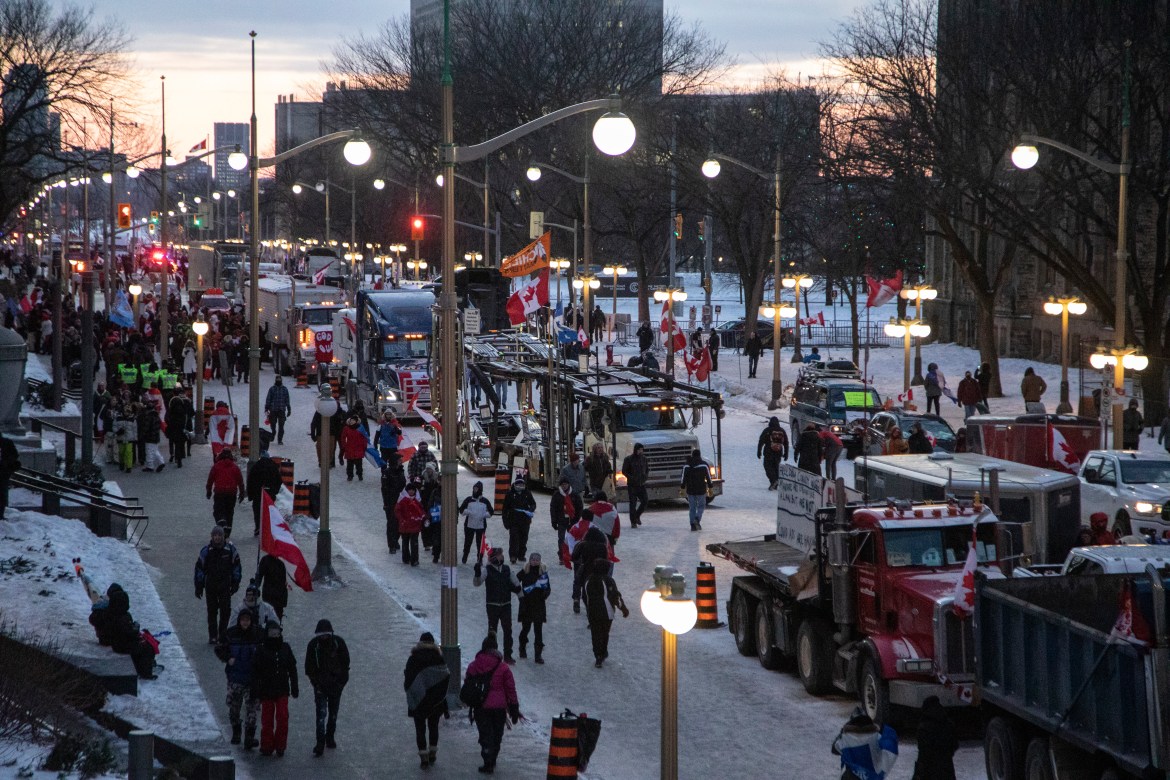

Canadian police say the protests have been partly funded by US supporters and Ontario froze funds donated via one US platform, GiveSendGo. Toronto-Dominion Bank has frozen two personal bank accounts into which 1.4 million Canadian dollars ($1.1m) had been deposited in support of the protesters. [Roger Lemoyne/Al Jazeera]
Canada Protesters, Police Deadlocked As Tensions Simmer At Blocked Border Bridge
By Kayla Tarnowski
02/13/22

By Kayla Tarnowski
02/13/22

Demonstrators gather downtown as truckers and supporters continue to protest coronavirus disease (COVID-19) vaccine mandates, in Ottawa, Ontario, Canada, February 12, 2022. Photo: Reuters / BLAIR GABLE
A tense standoff between Canadian police and protesters opposing COVID-19 restrictions was set to continue on Sunday, as a court order and threats of arrest have failed to end a blockade of a key Canada-U.S. border crossing.
President Joe Biden has asked Prime Minister Justin Trudeau to use federal powers to end the blockade of the Ambassador Bridge, North America's busiest land border crossing. Since Monday, protesters in trucks, cars and vans have blocked traffic in both directions, choking the supply chain for Detroit's carmakers.
Despite a court order to end the occupation and a state of emergency imposed by the province of Ontario, home to the city of Windsor, police have failed to disperse the crowd and resume cross-border traffic.
Police moved in early on Saturday, pushing protesters back from the foot of the bridge, but more people streamed into the area in the afternoon and the operation appeared to have stalled. Late on Saturday, Windsor Police arrested a 27-year old man for a criminal offence in relation to the demonstration.
"I am very hopeful still that police can ... try and get to these folks in a reasonable way and have them understand that it's time to move on," Windsor Mayor Drew Dilkens told CBC News. "We can no longer afford as a country to keep it closed."
The bridge carries about $360 million a day in two-way cargoes - 25% of the value of all U.S.-Canada goods trade.
Concrete barricades have been set up in front of the police near the bridge to keep protesters from reclaiming any ground.
The "Freedom Convoy" protests, started in the national capital Ottawa by Canadian truckers opposing a vaccinate-or-quarantine mandate for cross-border drivers, entered its 17th day on Sunday. But it has now morphed into a rallying point against broader COVID-19 curbs, carbon tax and other issues, with people joining in cars, pick-up trucks and farm vehicles.
Protests erupted across several cities in Canada on Saturday, with some 4,000 people in downtown Ottawa. Financial capital Toronto had some 1,000 demonstrators, though the police had shut key access roads to the central business district.
In the west, hundreds of protesters choked intersections along the Pacific Highway with vehicles leading to the Canada-U.S. border crossing in South Surrey, British Columbia. Several, camped out near the border crossing, vowed to stay "as long as is needed" until all COVID-19 restrictions are lifted.
Strangling bilateral trade, protests have spread to three border points, including in Alberta and Manitoba.
Canadian police have said the protests have been partly funded by U.S. supporters, and Ontario froze funds donated via one U.S. platform GiveSendGo on Thursday.
Ford Motor Co, the second-largest U.S. automaker, General Motors Co and Toyota Motor Corp all have announced production cuts. Companies have diverted cargo to stem losses during the cuts.
The estimated loss so far from the blockades to the auto industry alone could be as high as $850 million, based on IHS Markit's data, which puts the 2021 daily flow in vehicles and parts at $141.1 million a day.
"This is the busiest border crossing, so it's not just automotive," Mayor Dilkens said. "We are talking about things that impact the entire nation here. That's why finding a resolution is so important."
A tense standoff between Canadian police and protesters opposing COVID-19 restrictions was set to continue on Sunday, as a court order and threats of arrest have failed to end a blockade of a key Canada-U.S. border crossing.
President Joe Biden has asked Prime Minister Justin Trudeau to use federal powers to end the blockade of the Ambassador Bridge, North America's busiest land border crossing. Since Monday, protesters in trucks, cars and vans have blocked traffic in both directions, choking the supply chain for Detroit's carmakers.
Despite a court order to end the occupation and a state of emergency imposed by the province of Ontario, home to the city of Windsor, police have failed to disperse the crowd and resume cross-border traffic.
Police moved in early on Saturday, pushing protesters back from the foot of the bridge, but more people streamed into the area in the afternoon and the operation appeared to have stalled. Late on Saturday, Windsor Police arrested a 27-year old man for a criminal offence in relation to the demonstration.
"I am very hopeful still that police can ... try and get to these folks in a reasonable way and have them understand that it's time to move on," Windsor Mayor Drew Dilkens told CBC News. "We can no longer afford as a country to keep it closed."
The bridge carries about $360 million a day in two-way cargoes - 25% of the value of all U.S.-Canada goods trade.
Concrete barricades have been set up in front of the police near the bridge to keep protesters from reclaiming any ground.
The "Freedom Convoy" protests, started in the national capital Ottawa by Canadian truckers opposing a vaccinate-or-quarantine mandate for cross-border drivers, entered its 17th day on Sunday. But it has now morphed into a rallying point against broader COVID-19 curbs, carbon tax and other issues, with people joining in cars, pick-up trucks and farm vehicles.
Protests erupted across several cities in Canada on Saturday, with some 4,000 people in downtown Ottawa. Financial capital Toronto had some 1,000 demonstrators, though the police had shut key access roads to the central business district.
In the west, hundreds of protesters choked intersections along the Pacific Highway with vehicles leading to the Canada-U.S. border crossing in South Surrey, British Columbia. Several, camped out near the border crossing, vowed to stay "as long as is needed" until all COVID-19 restrictions are lifted.
Strangling bilateral trade, protests have spread to three border points, including in Alberta and Manitoba.
Canadian police have said the protests have been partly funded by U.S. supporters, and Ontario froze funds donated via one U.S. platform GiveSendGo on Thursday.
Ford Motor Co, the second-largest U.S. automaker, General Motors Co and Toyota Motor Corp all have announced production cuts. Companies have diverted cargo to stem losses during the cuts.
The estimated loss so far from the blockades to the auto industry alone could be as high as $850 million, based on IHS Markit's data, which puts the 2021 daily flow in vehicles and parts at $141.1 million a day.
"This is the busiest border crossing, so it's not just automotive," Mayor Dilkens said. "We are talking about things that impact the entire nation here. That's why finding a resolution is so important."
Blockades on Canada-US border continue as protests swell
BY ROB GILLIES AND MIKE HOUSEHOLDER• ASSOCIATED PRESS • FEBRUARY 13, 2022
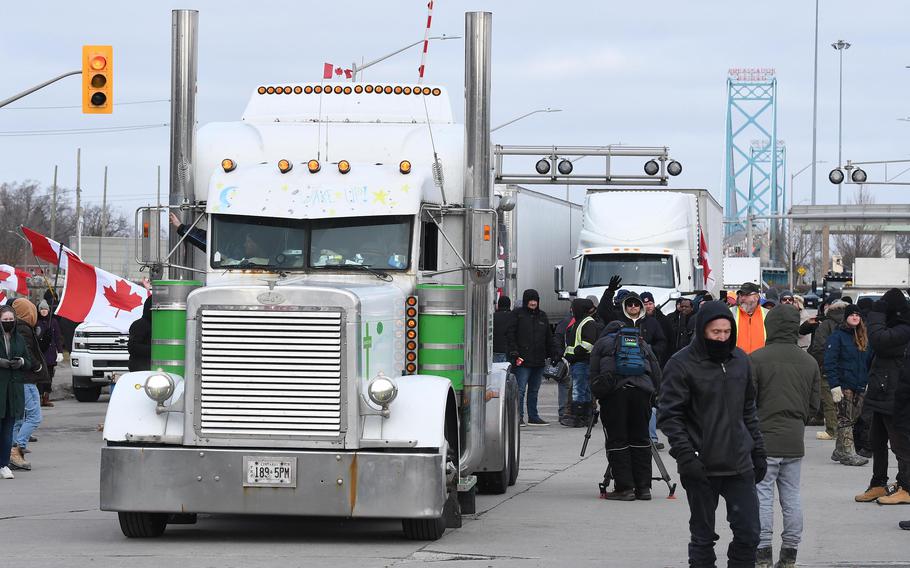
One of eight or nine semi trucks are finally moved down the road, opening the road to the bridge, part of the Ambassador Bridge protest, over Canada’s COVID-19 mandates, in Windsor, Canada on Saturday, Feb. 12, 2022. (Daniel Mears/ The Detroit News/TNS)
WINDSOR, Ontario — Hours after removing their vehicles blocking a key U.S.-Canadian border bridge, protesters opposed to COVID-19 vaccine mandates continued to block traffic outside in the bitter cold early Sunday, while in the capital Ottawa, police were forming a new command center with provincial and national authorities that they said would help them respond better to a larger demonstration that has paralyzed downtown.
The tense standoff at the Ambassador Bridge linking Detroit and Windsor, Ontario, eased somewhat Saturday when Canadian police persuaded demonstrators to move the trucks they had used to barricade the entrance to the busy international crossing. Early Saturday evening, crews set up concrete traffic barricades along the highway.
But protesters reconvened nearby — with reinforcements — and were still choking off access from the Canadian side, snarling traffic and commerce. About 180 remained late Saturday in the sub-freezing cold.
In Ottawa, the ranks of protesters swelled to what police said was 4,000 demonstrators. The city has seen that on past weekends, and loud music played as people milled about downtown where anti-vaccine demonstrators have been encamped since late January.
The protests at the bridge, in Ottawa and elsewhere have reverberated outside the country, with similarly inspired convoys in France, New Zealand and the Netherlands, and the U.S. Department of Homeland Security warned that truck convoys may be in the works in the United States.
An ex-Cabinet minister in Canadian Prime Minister Justin Trudeau's government took the unusual step of calling out her former federal colleagues as well as the province and city for not putting an end to the protests.
"Amazingly, this isn't just Ottawa. It's the nation's capital," Catherine McKenna tweeted. "But no one — not the city, the province or the federal government can seem to get their act together to end this illegal occupation. It's appalling. ... Just get your act together. Now."
Trudeau has so far rejected calls to use the military.
"The Prime Minister stressed that border crossings cannot, and will not, remain closed, and that all options are on the table," Trudeau's office said in a statement late Saturday after he met with senior officials. Trudeau has called the protesters a "fringe" of Canadian society.
Ottawa police said in a statement late Saturday that a joint command center had now been set up together with the Ontario Provincial Police and the Royal Canadian Mounted Police. They said that would beef up enforcement capabilities that had been limited by "safety concerns — arising from aggressive, illegal behavior by many demonstrators — limited police enforcement capabilities."
Police earlier issued a statement calling the protest an unlawful occupation and saying they were waiting for reinforcements before implementing a plan to end the demonstrations.
Ottawa Mayor Jim Watson declared a state of emergency last week for the capital, where hundreds of trucks remained in front of the Parliament Buildings and demonstrators have set up portable toilets outside the prime minister's office where Trudeau's motorcade usually parks.
Surrounded by dozens of officers in Windsor, a man with "Mandate Freedom" and "Trump 2024" spray-painted on his vehicle left the bridge entrance early in the day as others began dismantling a small, tarp-covered encampment. A trucker honked his horn as he, too, drove off, to cheers and chants of "Freedom!"
But hundreds more arrived to bolster the crowd and settled into a faceoff with police about two blocks away, waving flags and yelling. While there were no visible physical confrontations, the crowd still controlled the road to the bridge, and traffic had not resumed as of Sunday morning.
On Friday, a judge ordered an end to the blockade of mostly pickup trucks and cars, and Ontario Premier Doug Ford declared a state of emergency allowing for fines of 100,000 Canadian dollars and up to one year in jail for anyone illegally blocking roads, bridges, walkways and other critical infrastructure.
"The illegal blockades are impacting trade, supply chains & manufacturing. They're hurting Canadian families, workers & businesses. Glad to see the Windsor Police & its policing partners commenced enforcement at and near the Ambassador Bridge," Federal Innovation Minister Francois-Philippe Champagne tweeted Saturday. "These blockades must stop."
The Ambassador Bridge is the busiest U.S.-Canadian border crossing, carrying 25% of all trade between the two countries, and auto plants on both sides have been forced to shut down or reduce production this week. The standoff came at a time when the industry is already struggling to maintain production in the face of pandemic-induced shortages of computer chips and other supply-chain disruptions.
In Ottawa, 31-year-old Stephanie Ravensbergen said she turned out to support her aunt and uncle who have parked their semi in the streets since the beginning of the protest. She opposes vaccine and mask requirements, and said it's important for schoolchildren to be able see their friends' faces and emotions.
"We want the right to choose," Ravensbergen said. "We want the right to be able to do what everybody else can do."
Protesters on Saturday tore down a fence that authorities put up around the capital's National War Memorial two weeks ago after demonstrators urinated on it. Some later chanted "liberte," French for "freedom."
"Completely unacceptable," Lawrence MacAulay, Canada's veterans affairs minister, tweeted. "This behavior is disappointing and I'm calling on protesters to respect our monuments."
On the other side of the country, protesters disrupted operations at another border crossing between Surrey, British Columbia, and Blaine, Washington, but officials said it was not blocked. A border crossings in Alberta remained shut down as well.
While the protesters are decrying vaccine mandates for truckers and other COVID-19 restrictions, many of Canada's public health measures, such as mask rules and vaccine passports for getting into restaurants and theaters, are already falling away as the omicron surge levels off.
Pandemic restrictions have been far stricter there than in the U.S., but Canadians have largely supported them. The vast majority of Canadians are vaccinated, and the COVID-19 death rate is one-third that of the United States.
Householder reported from Windsor, and Gillies from Toronto. Associated Press writer Ted Shaffrey in Ottawa, Ontario, contributed to this report.
BY ROB GILLIES AND MIKE HOUSEHOLDER• ASSOCIATED PRESS • FEBRUARY 13, 2022

One of eight or nine semi trucks are finally moved down the road, opening the road to the bridge, part of the Ambassador Bridge protest, over Canada’s COVID-19 mandates, in Windsor, Canada on Saturday, Feb. 12, 2022. (Daniel Mears/ The Detroit News/TNS)
WINDSOR, Ontario — Hours after removing their vehicles blocking a key U.S.-Canadian border bridge, protesters opposed to COVID-19 vaccine mandates continued to block traffic outside in the bitter cold early Sunday, while in the capital Ottawa, police were forming a new command center with provincial and national authorities that they said would help them respond better to a larger demonstration that has paralyzed downtown.
The tense standoff at the Ambassador Bridge linking Detroit and Windsor, Ontario, eased somewhat Saturday when Canadian police persuaded demonstrators to move the trucks they had used to barricade the entrance to the busy international crossing. Early Saturday evening, crews set up concrete traffic barricades along the highway.
But protesters reconvened nearby — with reinforcements — and were still choking off access from the Canadian side, snarling traffic and commerce. About 180 remained late Saturday in the sub-freezing cold.
In Ottawa, the ranks of protesters swelled to what police said was 4,000 demonstrators. The city has seen that on past weekends, and loud music played as people milled about downtown where anti-vaccine demonstrators have been encamped since late January.
The protests at the bridge, in Ottawa and elsewhere have reverberated outside the country, with similarly inspired convoys in France, New Zealand and the Netherlands, and the U.S. Department of Homeland Security warned that truck convoys may be in the works in the United States.
An ex-Cabinet minister in Canadian Prime Minister Justin Trudeau's government took the unusual step of calling out her former federal colleagues as well as the province and city for not putting an end to the protests.
"Amazingly, this isn't just Ottawa. It's the nation's capital," Catherine McKenna tweeted. "But no one — not the city, the province or the federal government can seem to get their act together to end this illegal occupation. It's appalling. ... Just get your act together. Now."
Trudeau has so far rejected calls to use the military.
"The Prime Minister stressed that border crossings cannot, and will not, remain closed, and that all options are on the table," Trudeau's office said in a statement late Saturday after he met with senior officials. Trudeau has called the protesters a "fringe" of Canadian society.
Ottawa police said in a statement late Saturday that a joint command center had now been set up together with the Ontario Provincial Police and the Royal Canadian Mounted Police. They said that would beef up enforcement capabilities that had been limited by "safety concerns — arising from aggressive, illegal behavior by many demonstrators — limited police enforcement capabilities."
Police earlier issued a statement calling the protest an unlawful occupation and saying they were waiting for reinforcements before implementing a plan to end the demonstrations.
Ottawa Mayor Jim Watson declared a state of emergency last week for the capital, where hundreds of trucks remained in front of the Parliament Buildings and demonstrators have set up portable toilets outside the prime minister's office where Trudeau's motorcade usually parks.
Surrounded by dozens of officers in Windsor, a man with "Mandate Freedom" and "Trump 2024" spray-painted on his vehicle left the bridge entrance early in the day as others began dismantling a small, tarp-covered encampment. A trucker honked his horn as he, too, drove off, to cheers and chants of "Freedom!"
But hundreds more arrived to bolster the crowd and settled into a faceoff with police about two blocks away, waving flags and yelling. While there were no visible physical confrontations, the crowd still controlled the road to the bridge, and traffic had not resumed as of Sunday morning.
On Friday, a judge ordered an end to the blockade of mostly pickup trucks and cars, and Ontario Premier Doug Ford declared a state of emergency allowing for fines of 100,000 Canadian dollars and up to one year in jail for anyone illegally blocking roads, bridges, walkways and other critical infrastructure.
"The illegal blockades are impacting trade, supply chains & manufacturing. They're hurting Canadian families, workers & businesses. Glad to see the Windsor Police & its policing partners commenced enforcement at and near the Ambassador Bridge," Federal Innovation Minister Francois-Philippe Champagne tweeted Saturday. "These blockades must stop."
The Ambassador Bridge is the busiest U.S.-Canadian border crossing, carrying 25% of all trade between the two countries, and auto plants on both sides have been forced to shut down or reduce production this week. The standoff came at a time when the industry is already struggling to maintain production in the face of pandemic-induced shortages of computer chips and other supply-chain disruptions.
In Ottawa, 31-year-old Stephanie Ravensbergen said she turned out to support her aunt and uncle who have parked their semi in the streets since the beginning of the protest. She opposes vaccine and mask requirements, and said it's important for schoolchildren to be able see their friends' faces and emotions.
"We want the right to choose," Ravensbergen said. "We want the right to be able to do what everybody else can do."
Protesters on Saturday tore down a fence that authorities put up around the capital's National War Memorial two weeks ago after demonstrators urinated on it. Some later chanted "liberte," French for "freedom."
"Completely unacceptable," Lawrence MacAulay, Canada's veterans affairs minister, tweeted. "This behavior is disappointing and I'm calling on protesters to respect our monuments."
On the other side of the country, protesters disrupted operations at another border crossing between Surrey, British Columbia, and Blaine, Washington, but officials said it was not blocked. A border crossings in Alberta remained shut down as well.
While the protesters are decrying vaccine mandates for truckers and other COVID-19 restrictions, many of Canada's public health measures, such as mask rules and vaccine passports for getting into restaurants and theaters, are already falling away as the omicron surge levels off.
Pandemic restrictions have been far stricter there than in the U.S., but Canadians have largely supported them. The vast majority of Canadians are vaccinated, and the COVID-19 death rate is one-third that of the United States.
Householder reported from Windsor, and Gillies from Toronto. Associated Press writer Ted Shaffrey in Ottawa, Ontario, contributed to this report.
Canadian protesters flood key bridge to US again as COVID-19 demonstrations continue
Police by Saturday evening local time had still not cleared the strategic Ambassador Bridge, which links the city of Windsor in Canada to Detroit, Michigan in the United States.
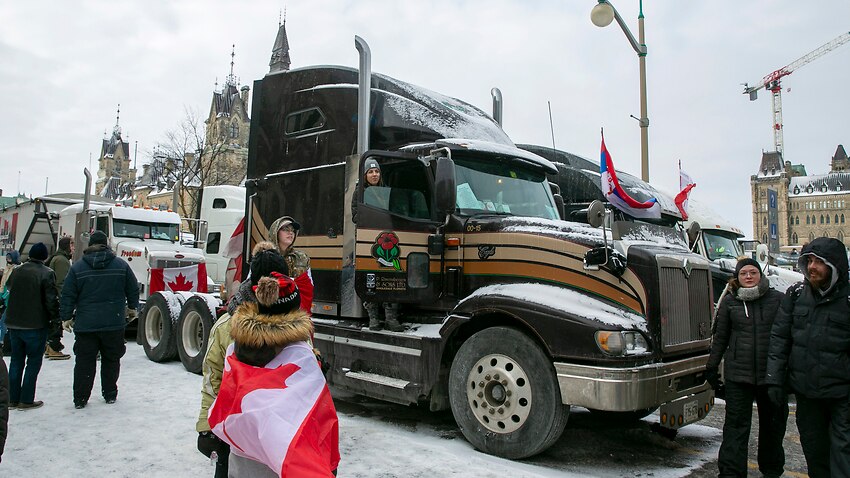
Stephanie Ravensbergen, 31, is in her family's truck in Ottawa, Canada.
READ MORE

Three arrested as thousands protest against vaccine mandates in Canberra
Since the movement began, some central Canadian provinces have announced plans to end mask and vaccine requirements in coming weeks, with the numbers of COVID-19 cases falling.
But the two most populous provinces - Ontario and Quebec - have yet to follow suit.
The Canadians are not alone in organanising mass protests around COVID-19 rules or vaccines mandates.
In Australia, an estimated 10,000 protesters marched through Canberra to the parliament building to decry vaccine mandates on Saturday.
In Paris on Saturday, police fired tear gas and issued hundreds of fines in an effort to break up convoys of vehicles coming from across France in a protest over COVID-19 restrictions and rising living costs.
While some protesters made it to the glitzy Champs-Elysees, they were unable to block the city's streets.
In the Netherlands, a vehicle convoy brought The Hague's city center to a standstill in another Canada-style protest.
In Switzerland, hundreds of protesters marched in Zurich to protest COVID-19 restrictions, while several thousand others rallied against them, Swiss media reported.
Both rallies were illegal, and police used tear gas, water cannons and rubber bullets to disperse the crowds.
And in New Zealand, anti-mandate activists have been camped on the lawns of parliament in Wellington for days in a protest inspired by the Canadian convoy.
Police by Saturday evening local time had still not cleared the strategic Ambassador Bridge, which links the city of Windsor in Canada to Detroit, Michigan in the United States.

Stephanie Ravensbergen, 31, is in her family's truck in Ottawa, Canada.
She opposes vaccine and mask requirements. Source: AP
Canadian demonstrators led by truckers angry over COVID-19 restrictions defied police and kept occupying a key bridge Saturday, while thousands more rallied in the capital as a two-week-old protest showed no signs of abating.
In Ontario, where authorities have declared a state of emergency, the provincial supreme court had ordered truckers to end their blockade of the strategic Ambassador Bridge, which links the city of Windsor in Canada to Detroit, Michigan in the United States.
It was the fifth straight day demonstrators occupied the key bridge.
The protest has forced major automakers in both countries to halt or scale back production and Washington on Friday urged Ottawa to use its federal powers to end the blockade.
Canada's Prime Minister Justin Trudeau promised "an increasingly robust police intervention," adding that borders cannot remain closed and "this conflict must end."
Canadian police, backed by armored vehicles, began clearing the bridge, taking down tents erected in traffic lanes and persuading some drivers to move their trucks.
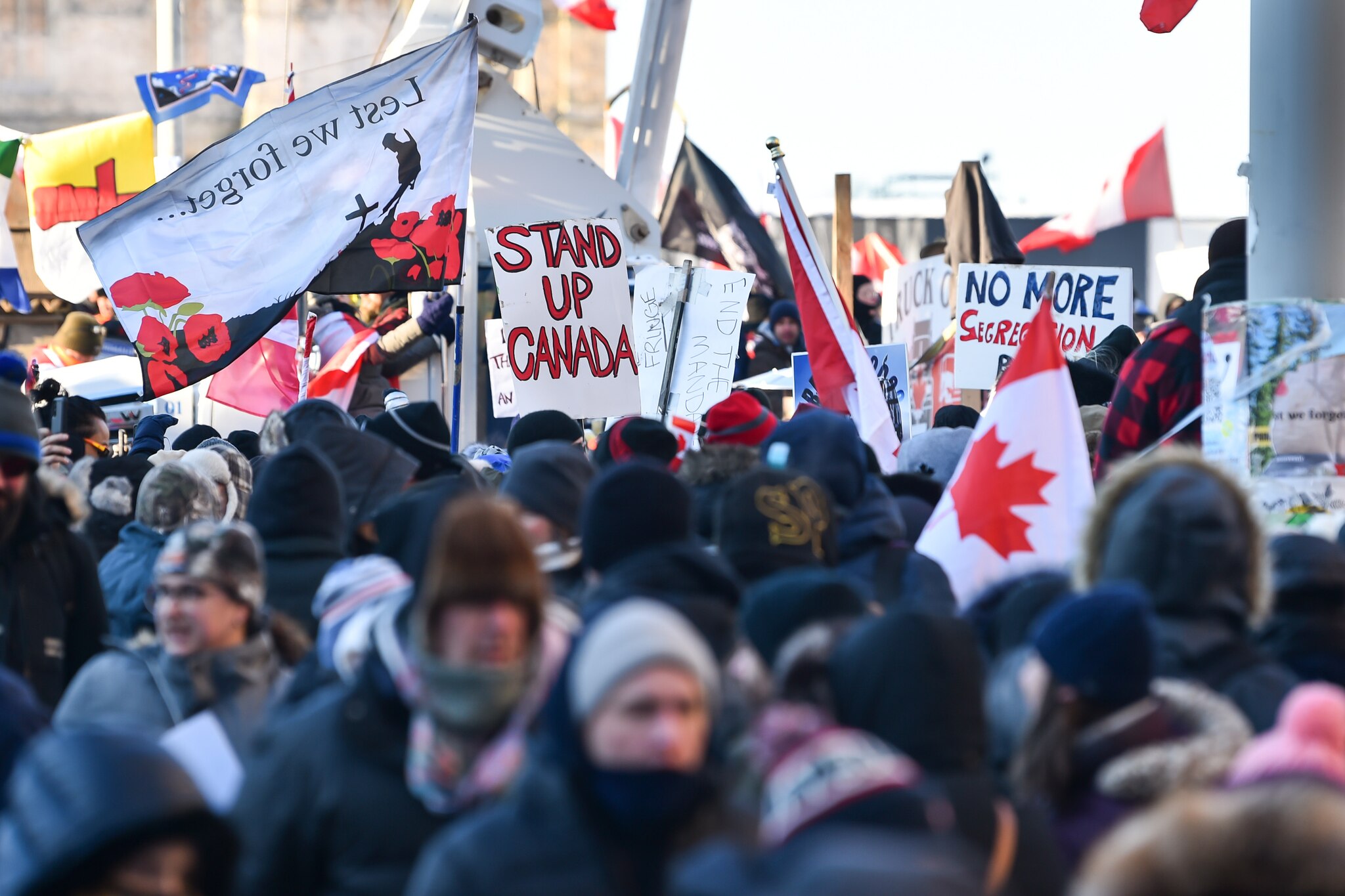
Protesters hold signs condemning the vaccine mandates imposed by Canadian Prime Minister Justin Trudeau in Ottawa, Canada. Source: Getty
But by Saturday evening local time, after hours of facing off against the demonstrators, the police had not completely cleared the span. Most of the cars and trucks blocking it were removed but hundreds of people refused to budge.
Windsor police spokesman Jason Bellaire said the aim was to clear the bridge peacefully, but he could not say if it would be cleared by the end of the day.
There were no immediate reports of arrests Saturday.
The Ambassador Bridge is vital to the US and Canadian auto industries, carrying more than 25 per cent of merchandise exported by both countries.
Two other US-Canada border crossings, one in Manitoba province and one in Alberta, remained blocked by protests on Saturday evening.
READ MORE

Canadian protesters refuse to end 'Freedom Convoy' despite gov warnings
In Ottawa, crowds of thousands packed the streets of the city centre, the epicenter of the movement, blaring horns, playing music, dancing and drinking hot coffee against the bitter cold. Very few police were on hand.
"I've been supporting the cause from the beginning," said 38-year-old Marc-Andre Mallette. "I'm not vaccinated and I'm not dead," added the sewer worker from the town of St-Armand, near the US border.
Truckers originally converged on Ottawa to press their demand for an end to a vaccination requirement affecting truckers crossing the international border.
But the movement has spread, as the protesters - mostly insisting they want to protect their freedoms, but some displaying swastikas or Confederate flags - now seek an end to all vaccine mandates, whether imposed by the federal or provincial governments.
Anti-Trudeau signs and chants have become common along the clogged Ottawa streets.
Political opponents say the prime minister has been far too slow to bring the protests to an end.
Mr Trudeau has repeatedly insisted the protesters represent a small - if noisy - fraction of a population that has largely followed vaccination requirements and guidance.
But anti-COVID measures in some provinces have been more restrictive than in much of the world, and the truckers' message has resonated more widely than authorities expected.
One opinion survey found that a third of Canadians support the protest movement, while 44 per cent say they at least understand the truckers' frustrations.
Canadian demonstrators led by truckers angry over COVID-19 restrictions defied police and kept occupying a key bridge Saturday, while thousands more rallied in the capital as a two-week-old protest showed no signs of abating.
In Ontario, where authorities have declared a state of emergency, the provincial supreme court had ordered truckers to end their blockade of the strategic Ambassador Bridge, which links the city of Windsor in Canada to Detroit, Michigan in the United States.
It was the fifth straight day demonstrators occupied the key bridge.
The protest has forced major automakers in both countries to halt or scale back production and Washington on Friday urged Ottawa to use its federal powers to end the blockade.
Canada's Prime Minister Justin Trudeau promised "an increasingly robust police intervention," adding that borders cannot remain closed and "this conflict must end."
Canadian police, backed by armored vehicles, began clearing the bridge, taking down tents erected in traffic lanes and persuading some drivers to move their trucks.

Protesters hold signs condemning the vaccine mandates imposed by Canadian Prime Minister Justin Trudeau in Ottawa, Canada. Source: Getty
But by Saturday evening local time, after hours of facing off against the demonstrators, the police had not completely cleared the span. Most of the cars and trucks blocking it were removed but hundreds of people refused to budge.
Windsor police spokesman Jason Bellaire said the aim was to clear the bridge peacefully, but he could not say if it would be cleared by the end of the day.
There were no immediate reports of arrests Saturday.
The Ambassador Bridge is vital to the US and Canadian auto industries, carrying more than 25 per cent of merchandise exported by both countries.
Two other US-Canada border crossings, one in Manitoba province and one in Alberta, remained blocked by protests on Saturday evening.
READ MORE

Canadian protesters refuse to end 'Freedom Convoy' despite gov warnings
In Ottawa, crowds of thousands packed the streets of the city centre, the epicenter of the movement, blaring horns, playing music, dancing and drinking hot coffee against the bitter cold. Very few police were on hand.
"I've been supporting the cause from the beginning," said 38-year-old Marc-Andre Mallette. "I'm not vaccinated and I'm not dead," added the sewer worker from the town of St-Armand, near the US border.
Truckers originally converged on Ottawa to press their demand for an end to a vaccination requirement affecting truckers crossing the international border.
But the movement has spread, as the protesters - mostly insisting they want to protect their freedoms, but some displaying swastikas or Confederate flags - now seek an end to all vaccine mandates, whether imposed by the federal or provincial governments.
Anti-Trudeau signs and chants have become common along the clogged Ottawa streets.
Political opponents say the prime minister has been far too slow to bring the protests to an end.
Mr Trudeau has repeatedly insisted the protesters represent a small - if noisy - fraction of a population that has largely followed vaccination requirements and guidance.
But anti-COVID measures in some provinces have been more restrictive than in much of the world, and the truckers' message has resonated more widely than authorities expected.
One opinion survey found that a third of Canadians support the protest movement, while 44 per cent say they at least understand the truckers' frustrations.
READ MORE

Three arrested as thousands protest against vaccine mandates in Canberra
Since the movement began, some central Canadian provinces have announced plans to end mask and vaccine requirements in coming weeks, with the numbers of COVID-19 cases falling.
But the two most populous provinces - Ontario and Quebec - have yet to follow suit.
The Canadians are not alone in organanising mass protests around COVID-19 rules or vaccines mandates.
In Australia, an estimated 10,000 protesters marched through Canberra to the parliament building to decry vaccine mandates on Saturday.
In Paris on Saturday, police fired tear gas and issued hundreds of fines in an effort to break up convoys of vehicles coming from across France in a protest over COVID-19 restrictions and rising living costs.
While some protesters made it to the glitzy Champs-Elysees, they were unable to block the city's streets.
In the Netherlands, a vehicle convoy brought The Hague's city center to a standstill in another Canada-style protest.
In Switzerland, hundreds of protesters marched in Zurich to protest COVID-19 restrictions, while several thousand others rallied against them, Swiss media reported.
Both rallies were illegal, and police used tear gas, water cannons and rubber bullets to disperse the crowds.
And in New Zealand, anti-mandate activists have been camped on the lawns of parliament in Wellington for days in a protest inspired by the Canadian convoy.
Agence France-Presse
February 12, 2022

Canadian police deploy on February 12, 2022, to move protesters blocking access to the Ambassador Bridge and demanding an end to government Covid-19 mandates, in Windsor, Ontario Geoff Robins AFP
Police in Canada were positioning Saturday to clear a key bridge on the US border, snarled for days by truckers protesting against vaccination rules, an AFP journalist observed.
"We urge all demonstrators to act lawfully & peacefully," police in Windsor, Ontario tweeted in announcing the deployment.
The normally busy Ambassador Bridge links Windsor to the US city of Detroit, Michigan.
Dozens of police officers and vehicles had arrived on the scene by 8:00 am (13H00 GMT) and begun taking positions near the approximately 50 protesters whose big trucks, vans and pick-ups have blocked the major trade link for six days.
On Friday, the Supreme Court of Ontario province ordered the demonstrators to end their blockade.
With the protests increasingly impacting the US auto industry, US President Joe Biden's administration has implored the government of Prime Minister Justin Trudeau to end the blockage.
But those occupying the Ambassador Bridge seemed largely unmoved.
The protest has affected automakers on both sides of the border, prompting Toyota to pause some production in Canada and Ford Motor Company to fly parts in, the Windsor Star newspaper reported.
The industry, one of the most important in Ontario, was already facing serious challenges from Covid-19, supply-chain disruption and bad weather.
Ontario premier Doug Ford has warned protesters that they could face fines of up to Can$100,000 ($78,500), up to a year in prison and revocation of their driver's licenses if they continue blocking traffic.
Protests began about two weeks ago when truckers drove into capital city Ottawa to demand an end to a vaccination requirement affecting truckers crossing the international border.
But the movement has spread to several other cities and border crossings, and copycat protests have now sprung up in other countries such as France and New Zealand.
The Canadian protesters -- mostly insisting they want to protect their freedoms, but some displaying swastikas or Confederate flags -- are now demanding an end to all vaccine mandates, whether imposed by the federal or the provincial governments.
© 2022 AFP
Canada truckers defy order to clear key bridge as protests swell
Agence France-Presse
February 12, 2022

Protesters block the roadway at the Ambassador Bridge border crossing in Windsor, Ontario, Canada on February 11, 2022 (AFP)
- Truckers snarling a key bridge between Canada and the United States over vaccination rules defied a judge's order to leave Friday night, with snowballing protests piling pressure on Prime Minister Justin Trudeau.
The days-long blockade of the Ambassador Bridge -- connecting Windsor, Ontario, and the US city of Detroit -- has paralyzed a key North American trade route, with Trudeau looking to resolve a crisis that has threatened to morph into a populist movement.
Protesters have defied a Canadian judge's order to clear the suspension bridge as many others piled into the capital Ottawa -- where the streets have been clogged with hundreds of big rigs for a fortnight -- and copycat demonstrations as far away as France and New Zealand continued.
Windsor mayor Drew Dilkens had said a court order required the truckers to clear roads by 7:00 pm local time (0000 GMT) but their numbers continued to swell as the deadline came and went.
Two other border crossings are also blocked: the first, at Emerson, connects the province of Manitoba to North Dakota, while the second is in Alberta.
Protests in Paris
Inspired by the Canadian truckers, thousands of protesters encamped on the outskirts of Paris early Saturday resumed their way to the French capital in convoys of vehicles, defying a ban by authorities who are determined to prevent any blockade of the city.
The demonstrators included opponents of Covid-19 vaccinations as well as people angry at fast-rising energy prices -- in an echo of the "yellow vest" grievances that sparked widespread protests in 2018 and 2019.
Nearly 7,200 police and gendarmes "are being deployed over the next three days to enforce the ban on vehicle convoys," Paris police headquarters said.
A makeshift camp has similarly sprung up outside New Zealand's parliament, the scene of violent clashes earlier this week as police sought to clear anti-vaccine demonstrators.
'Intimidation'
Ottawa is expecting another influx of protesters Saturday, with a stage set up in front of parliament and crowds growing larger than they have been in recent days, an AFP journalist said.
On Thursday evening, Ford's government separately obtained a court order barring anyone from tapping the millions of dollars raised by the convoy through the platform GiveSendGo after their fundraising efforts on GoFundMe were terminated. The site said the campaign violated its terms of service.
Trudeau said Friday: "Canadian banks are monitoring financial activity very closely and taking action as necessary."
But sitting across from Ottawa's Gothic revival parliament buildings, Matt Lehner said he was "not worried."
"We are standing up for what we believe in, we are not breaking any laws," he told AFP, a Canadian flag hanging from the end of his hockey stick as he waited for the "thousands" of Canadians who will join the protests this weekend.
Agence France-Presse
February 12, 2022

Protesters block the roadway at the Ambassador Bridge border crossing in Windsor, Ontario, Canada on February 11, 2022 (AFP)
- Truckers snarling a key bridge between Canada and the United States over vaccination rules defied a judge's order to leave Friday night, with snowballing protests piling pressure on Prime Minister Justin Trudeau.
The days-long blockade of the Ambassador Bridge -- connecting Windsor, Ontario, and the US city of Detroit -- has paralyzed a key North American trade route, with Trudeau looking to resolve a crisis that has threatened to morph into a populist movement.
Protesters have defied a Canadian judge's order to clear the suspension bridge as many others piled into the capital Ottawa -- where the streets have been clogged with hundreds of big rigs for a fortnight -- and copycat demonstrations as far away as France and New Zealand continued.
Windsor mayor Drew Dilkens had said a court order required the truckers to clear roads by 7:00 pm local time (0000 GMT) but their numbers continued to swell as the deadline came and went.
Two other border crossings are also blocked: the first, at Emerson, connects the province of Manitoba to North Dakota, while the second is in Alberta.
Upping the stakes, US President Joe Biden Friday reiterated his "concern" to Trudeau, telling him the blockades were having serious effects on US firms.
The actions have already had significant economic impact, with automakers forced to cut production on both sides of the border, triggering fears it could undermine Canada's recovery from the coronavirus pandemic.
The Ambassador Bridge is used daily by more than 40,000 people, along with trucks carrying $323 million worth of goods on average -- about one-quarter of all Canada-US trade.
Authorities are under increasing pressure to crack down on the demonstrations that have paralyzed Ottawa.
Trudeau said all options were "on the table" for ending the protests. But speaking to reporters in the capital, he reiterated that calling in the military was a distant final resort, and "something to avoid having to do at all costs."
"This unlawful activity has to end and it will end," the prime minister said, adding that it was up to police to "enforce the law and protect public order."
Ottawa police have said they are "not in a position" to end the demonstration without reinforcements.
The premier of Ontario province -- which includes both Ottawa and Windsor -- announced a state of emergency on Friday, threatening steep fines of up to 100,000 Canadian dollars ($80,000) and jail unless protesters end their "illegal occupation."
Doug Ford said he understood "frustrations have reached a boiling point for many Canadians" but warned "this is no longer a protest."
He has accused the truckers of "targeting our lifeline for food, fuel and goods across our borders" while "trying to force a political agenda through disruption, intimidation, and chaos."
The self-styled "Freedom Convoy" began in the country's west in anger at requirements that truckers either be vaccinated or test and isolate when crossing the US-Canada border -- but has morphed into a broader protest against pandemic health rules and Trudeau's government.
The actions have already had significant economic impact, with automakers forced to cut production on both sides of the border, triggering fears it could undermine Canada's recovery from the coronavirus pandemic.
The Ambassador Bridge is used daily by more than 40,000 people, along with trucks carrying $323 million worth of goods on average -- about one-quarter of all Canada-US trade.
Authorities are under increasing pressure to crack down on the demonstrations that have paralyzed Ottawa.
Trudeau said all options were "on the table" for ending the protests. But speaking to reporters in the capital, he reiterated that calling in the military was a distant final resort, and "something to avoid having to do at all costs."
"This unlawful activity has to end and it will end," the prime minister said, adding that it was up to police to "enforce the law and protect public order."
Ottawa police have said they are "not in a position" to end the demonstration without reinforcements.
The premier of Ontario province -- which includes both Ottawa and Windsor -- announced a state of emergency on Friday, threatening steep fines of up to 100,000 Canadian dollars ($80,000) and jail unless protesters end their "illegal occupation."
Doug Ford said he understood "frustrations have reached a boiling point for many Canadians" but warned "this is no longer a protest."
He has accused the truckers of "targeting our lifeline for food, fuel and goods across our borders" while "trying to force a political agenda through disruption, intimidation, and chaos."
The self-styled "Freedom Convoy" began in the country's west in anger at requirements that truckers either be vaccinated or test and isolate when crossing the US-Canada border -- but has morphed into a broader protest against pandemic health rules and Trudeau's government.
Protests in Paris
Inspired by the Canadian truckers, thousands of protesters encamped on the outskirts of Paris early Saturday resumed their way to the French capital in convoys of vehicles, defying a ban by authorities who are determined to prevent any blockade of the city.
The demonstrators included opponents of Covid-19 vaccinations as well as people angry at fast-rising energy prices -- in an echo of the "yellow vest" grievances that sparked widespread protests in 2018 and 2019.
Nearly 7,200 police and gendarmes "are being deployed over the next three days to enforce the ban on vehicle convoys," Paris police headquarters said.
A makeshift camp has similarly sprung up outside New Zealand's parliament, the scene of violent clashes earlier this week as police sought to clear anti-vaccine demonstrators.
'Intimidation'
Ottawa is expecting another influx of protesters Saturday, with a stage set up in front of parliament and crowds growing larger than they have been in recent days, an AFP journalist said.
On Thursday evening, Ford's government separately obtained a court order barring anyone from tapping the millions of dollars raised by the convoy through the platform GiveSendGo after their fundraising efforts on GoFundMe were terminated. The site said the campaign violated its terms of service.
Trudeau said Friday: "Canadian banks are monitoring financial activity very closely and taking action as necessary."
But sitting across from Ottawa's Gothic revival parliament buildings, Matt Lehner said he was "not worried."
"We are standing up for what we believe in, we are not breaking any laws," he told AFP, a Canadian flag hanging from the end of his hockey stick as he waited for the "thousands" of Canadians who will join the protests this weekend.
Canada police in standoff with protesters blocking bridge to U.S.
Reuters
Kayla Tarnowski and Carlos Osorio
“It would essentially send a message that the state is not able to retain control, where it’s attempted to do so,” Michael Kempa, an associate professor of criminology at the University of Ottawa, told CBC News.
“The longer this drags on, the longer people have the idea that what they are doing is not an illegal protest,” he said.
The Ambassador Bridge is North America’s busiest land border crossing. Since Monday, protesters in trucks, cars and vans have blocked traffic in both directions, choking the supply chain https://www.reuters.com/world/us/gm-cancels-two-shifts-lansing-plant-following-canadian-trucking-protests-2022-02-10 for Detroit’s carmakers.
The “Freedom Convoy” protests, started in the capital Ottawa by Canadian truckers opposing a vaccinate-or-quarantine mandate for cross-border drivers, entered its 16th day on Saturday. It has morphed into a wider protest https://www.reuters.com/world/americas/how-ottawas-anti-vaccine-mandate-protests-are-spreading-globally-2022-02-09 against COVID-19 curbs, with people joining in with smaller vehicles, including cars, vans and pick-up trucks.
Early on Saturday, Windsor Police urged demonstrators to act lawfully and peacefully. Officers in black uniforms with yellow vests moved behind the demonstrators’ vehicles and, accompanied by police cruisers, slowly advanced on the protesters, pushing them back from the bridge entrance.
The number of demonstrators had thinned to roughly two dozen early on Saturday from about 200 on Friday night.
“We are opening up this intersection to traffic. If you fail to comply with our instructions you will be arrested,” police told the crowd via a loudspeaker.
Protesters moved back in a noisy but peaceful retreat, dismantling tents and barbecues. But since then, police have not progressed, witnesses said.
Ottawa Police said they were waiting for reinforcements to end the “unlawful occupation” in the capital. Demonstrators there “exhibited aggressive behavior towards law enforcement” and tore down a fence that had been erected around the National War Memorial.
Protests have spread to three border points: the Ambassador Bridge, strangling trade between the two countries, and two smaller crossings in Alberta and Manitoba.
Canadian police have said the protests have been partly funded by U.S. supporters and Ontario froze funds donated via one U.S. platform, GiveSendGo, on Thursday.
Toronto-Dominion Bank has frozen two personal bank accounts into which C$1.4 million ($1.1 million) had been deposited in support of the protesters.
COPYCAT PROTESTS
The protests have inspired similar convoys and plans in the United States, France, New Zealand and Australia.
In Paris, French police fired tear gas https://www.reuters.com/world/europe/police-stop-50-vehicles-heading-paris-protest-convoy-2022-02-12 at demonstrators on the Champs Elysees avenue on Saturday shortly after a convoy carrying protesters against COVID-19 restrictions made it into the capital.
In Canada’s financial capital Toronto, police blocked main roads leading to the central business district, ahead of a planned protest on Saturday. A convoy of motorists in the United States is planning to head to the waterfront in Port Huron, Michigan, in support of protesters in Canada.
Another U.S. group said two separate vehicle convoys will converge this weekend at the Peace Bridge, another U.S.-Canadian border crossing in Buffalo, New York.
Ford, the second-largest U.S. automaker, General Motors and Toyota Motor Co all have announced production cuts. Companies have diverted cargo to stem losses amid production cuts.
The estimated loss from the blockades just to the automobile industry could be as high as $700 million, based on IHS Markit’s data, which puts the daily flow in vehicles and parts at $141.1 million day in 2021.
Prime Minister Justin Trudeau has come under pressure from opposition party leaders to intervene. Trudeau is scheduled to chair a meeting of his top advisors on Saturday, called the Incident Response Group, to discuss the situation.
Reuters
Kayla Tarnowski and Carlos Osorio
Publishing date: Feb 12, 2022 •
WINDSOR — A standoff between Canadian police and protesters blocking a key bridge to the United States continued on Saturday, more than seven hours after authorities moved in seeking to end the blockade of the important trade corridor.
Demonstrators opposing the government’s strict pandemic restrictions have occupied the Ambassador Bridge for the fifth straight day, snarling international trade and prompting President Joe Biden to call for an end to the siege. But there was still no sign when traffic would resume.
While police have successfully pushed back protesters from the foot of the Ambassador Bridge, more people were streaming into the area and the operation appeared to have stalled.
As the afternoon dragged on, some Canadians questioned what was behind the delay, given the order issued by a court on Friday to end the blockade and the imposition of a state of emergency declared by Ontario authorities.
WINDSOR — A standoff between Canadian police and protesters blocking a key bridge to the United States continued on Saturday, more than seven hours after authorities moved in seeking to end the blockade of the important trade corridor.
Demonstrators opposing the government’s strict pandemic restrictions have occupied the Ambassador Bridge for the fifth straight day, snarling international trade and prompting President Joe Biden to call for an end to the siege. But there was still no sign when traffic would resume.
While police have successfully pushed back protesters from the foot of the Ambassador Bridge, more people were streaming into the area and the operation appeared to have stalled.
As the afternoon dragged on, some Canadians questioned what was behind the delay, given the order issued by a court on Friday to end the blockade and the imposition of a state of emergency declared by Ontario authorities.
“It would essentially send a message that the state is not able to retain control, where it’s attempted to do so,” Michael Kempa, an associate professor of criminology at the University of Ottawa, told CBC News.
“The longer this drags on, the longer people have the idea that what they are doing is not an illegal protest,” he said.
The Ambassador Bridge is North America’s busiest land border crossing. Since Monday, protesters in trucks, cars and vans have blocked traffic in both directions, choking the supply chain https://www.reuters.com/world/us/gm-cancels-two-shifts-lansing-plant-following-canadian-trucking-protests-2022-02-10 for Detroit’s carmakers.
The “Freedom Convoy” protests, started in the capital Ottawa by Canadian truckers opposing a vaccinate-or-quarantine mandate for cross-border drivers, entered its 16th day on Saturday. It has morphed into a wider protest https://www.reuters.com/world/americas/how-ottawas-anti-vaccine-mandate-protests-are-spreading-globally-2022-02-09 against COVID-19 curbs, with people joining in with smaller vehicles, including cars, vans and pick-up trucks.
Early on Saturday, Windsor Police urged demonstrators to act lawfully and peacefully. Officers in black uniforms with yellow vests moved behind the demonstrators’ vehicles and, accompanied by police cruisers, slowly advanced on the protesters, pushing them back from the bridge entrance.
The number of demonstrators had thinned to roughly two dozen early on Saturday from about 200 on Friday night.
“We are opening up this intersection to traffic. If you fail to comply with our instructions you will be arrested,” police told the crowd via a loudspeaker.
Protesters moved back in a noisy but peaceful retreat, dismantling tents and barbecues. But since then, police have not progressed, witnesses said.
Ottawa Police said they were waiting for reinforcements to end the “unlawful occupation” in the capital. Demonstrators there “exhibited aggressive behavior towards law enforcement” and tore down a fence that had been erected around the National War Memorial.
Protests have spread to three border points: the Ambassador Bridge, strangling trade between the two countries, and two smaller crossings in Alberta and Manitoba.
Canadian police have said the protests have been partly funded by U.S. supporters and Ontario froze funds donated via one U.S. platform, GiveSendGo, on Thursday.
Toronto-Dominion Bank has frozen two personal bank accounts into which C$1.4 million ($1.1 million) had been deposited in support of the protesters.
COPYCAT PROTESTS
The protests have inspired similar convoys and plans in the United States, France, New Zealand and Australia.
In Paris, French police fired tear gas https://www.reuters.com/world/europe/police-stop-50-vehicles-heading-paris-protest-convoy-2022-02-12 at demonstrators on the Champs Elysees avenue on Saturday shortly after a convoy carrying protesters against COVID-19 restrictions made it into the capital.
In Canada’s financial capital Toronto, police blocked main roads leading to the central business district, ahead of a planned protest on Saturday. A convoy of motorists in the United States is planning to head to the waterfront in Port Huron, Michigan, in support of protesters in Canada.
Another U.S. group said two separate vehicle convoys will converge this weekend at the Peace Bridge, another U.S.-Canadian border crossing in Buffalo, New York.
Ford, the second-largest U.S. automaker, General Motors and Toyota Motor Co all have announced production cuts. Companies have diverted cargo to stem losses amid production cuts.
The estimated loss from the blockades just to the automobile industry could be as high as $700 million, based on IHS Markit’s data, which puts the daily flow in vehicles and parts at $141.1 million day in 2021.
Prime Minister Justin Trudeau has come under pressure from opposition party leaders to intervene. Trudeau is scheduled to chair a meeting of his top advisors on Saturday, called the Incident Response Group, to discuss the situation.
(Reporting by Kayla Tarnowski and Carlos Osorio in Windsor; Writing by Denny Thomas; Editing by Angus MacSwan, Amran Abocar and Daniel Wallis)
Police clear out truckers, but protesters on foot keep U.S.-Canada bridge closed
By Elena Moore
Published February 12, 2022
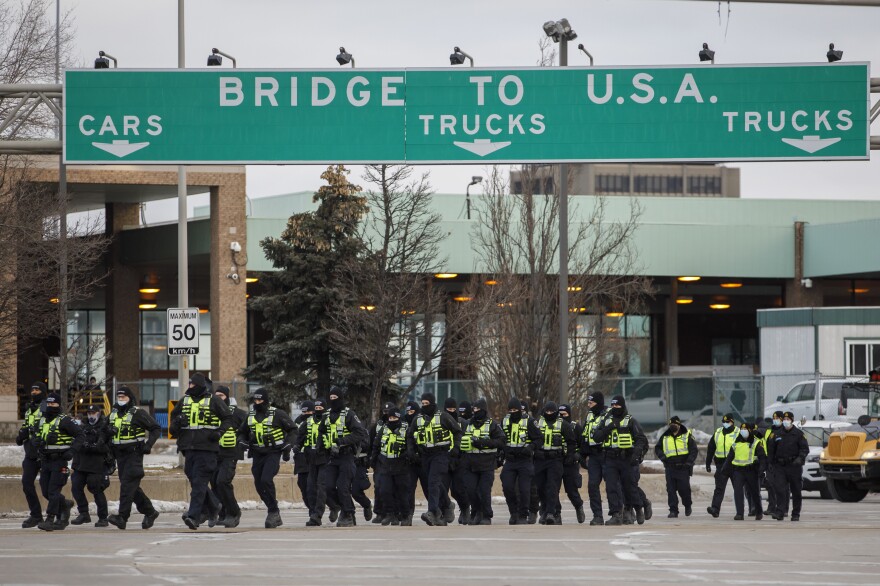
Cole Burston
Police arrive to clear protesters and their vehicles from a blockade at the entrance to the Ambassador Bridge in Windsor, Ontario on Saturday.
After police stepped in Saturday, protesters in trucks and other vehicles left a bridge between the United States and Canada, marking a potential turning point in the fifth day of protests that have disrupted a crucial border trade crossing.
But as of Saturday afternoon, hundreds of protesters were walking around the Ambassador Bridge in Windsor, Ontario, according to The Detroit News — a significant increase from the morning, when only a few dozen were present. It was unclear when the bridge would reopen.
Throughout the week, hordes of truckers parked pickup and semis across the bridge, protesting Canada's COVID-19 vaccine mandate and additional public health precautions that Prime Minister Justin Trudeau implemented.
"Enforcement continuing, individuals who are located within the demonstration area are subject to arrest. People are advised to immediately vacate the area," Windsor police tweeted just a few hours after announcing it had "commenced enforcement" at the bridge.
The process of beginning to remove the truckers marks a change from Friday night when the crowds grew in size, disregarding federal orders to disperse.
On Friday, Ontario Premier Doug Ford declared a state of emergency — signaling that any protesters arrested would be met with fines reaching $100,000 and could face up to a year in jail.
The order prompted Ontario Superior Court Chief Justice Geoffrey Morawetz to intervene, issuing an injunction that gave protesters until 7 p.m. Friday to leave without facing punishment.
But many truckers stayed, deciding to continue the blockade through the night.
The blockade has hampered automakers
The Ambassador Bridge marks a key border crossing — a fourth of U.S.-Canada trade passes through it.
The blockade has particularly worsened supply-chain problems and caused production delays across the auto industry.
Major automakers, including General Motors, Ford and Stellantis, were forced to cancel shifts or reduce capacity at locations in Michigan and Ontario.
Canada has seen a frenzy of similar protests over the past weeks, including within the capital city of Ottawa and at U.S. border crossings in Alberta and Manitoba.
"I want to make something very clear," Trudeau said in an address Friday night. "The illegal blockades seeking to take our neighborhoods and our economy hostage, and that collective COVID fatigue we are facing, are two very separate things. If you joined the protests because you're tired of COVID, you now need to understand you're breaking laws.
"We've heard your frustration with COVID, with the measures that are there to keep people safe," Trudeau added, "We've heard you. It's time to go home now."
Copyright 2022 NPR. To see more, visit https://www.npr.org.

Elena Moore is a production assistant for the NPR Politics Podcast. She also fills in as a reporter for the NewsDesk. Moore previously worked as a production assistant for Morning Edition. During the 2020 presidential campaign, she worked for the Washington Desk as an editorial assistant, doing both research and reporting. Before coming to NPR, Moore worked at NBC News. She is a graduate of The George Washington University in Washington, D.C., and is originally and proudly from Brooklyn, N.Y.
By Elena Moore
Published February 12, 2022

Cole Burston
Police arrive to clear protesters and their vehicles from a blockade at the entrance to the Ambassador Bridge in Windsor, Ontario on Saturday.
After police stepped in Saturday, protesters in trucks and other vehicles left a bridge between the United States and Canada, marking a potential turning point in the fifth day of protests that have disrupted a crucial border trade crossing.
But as of Saturday afternoon, hundreds of protesters were walking around the Ambassador Bridge in Windsor, Ontario, according to The Detroit News — a significant increase from the morning, when only a few dozen were present. It was unclear when the bridge would reopen.
Throughout the week, hordes of truckers parked pickup and semis across the bridge, protesting Canada's COVID-19 vaccine mandate and additional public health precautions that Prime Minister Justin Trudeau implemented.
"Enforcement continuing, individuals who are located within the demonstration area are subject to arrest. People are advised to immediately vacate the area," Windsor police tweeted just a few hours after announcing it had "commenced enforcement" at the bridge.
The process of beginning to remove the truckers marks a change from Friday night when the crowds grew in size, disregarding federal orders to disperse.
On Friday, Ontario Premier Doug Ford declared a state of emergency — signaling that any protesters arrested would be met with fines reaching $100,000 and could face up to a year in jail.
The order prompted Ontario Superior Court Chief Justice Geoffrey Morawetz to intervene, issuing an injunction that gave protesters until 7 p.m. Friday to leave without facing punishment.
But many truckers stayed, deciding to continue the blockade through the night.
The blockade has hampered automakers
The Ambassador Bridge marks a key border crossing — a fourth of U.S.-Canada trade passes through it.
The blockade has particularly worsened supply-chain problems and caused production delays across the auto industry.
Major automakers, including General Motors, Ford and Stellantis, were forced to cancel shifts or reduce capacity at locations in Michigan and Ontario.
Canada has seen a frenzy of similar protests over the past weeks, including within the capital city of Ottawa and at U.S. border crossings in Alberta and Manitoba.
"I want to make something very clear," Trudeau said in an address Friday night. "The illegal blockades seeking to take our neighborhoods and our economy hostage, and that collective COVID fatigue we are facing, are two very separate things. If you joined the protests because you're tired of COVID, you now need to understand you're breaking laws.
"We've heard your frustration with COVID, with the measures that are there to keep people safe," Trudeau added, "We've heard you. It's time to go home now."
Copyright 2022 NPR. To see more, visit https://www.npr.org.

Elena Moore is a production assistant for the NPR Politics Podcast. She also fills in as a reporter for the NewsDesk. Moore previously worked as a production assistant for Morning Edition. During the 2020 presidential campaign, she worked for the Washington Desk as an editorial assistant, doing both research and reporting. Before coming to NPR, Moore worked at NBC News. She is a graduate of The George Washington University in Washington, D.C., and is originally and proudly from Brooklyn, N.Y.

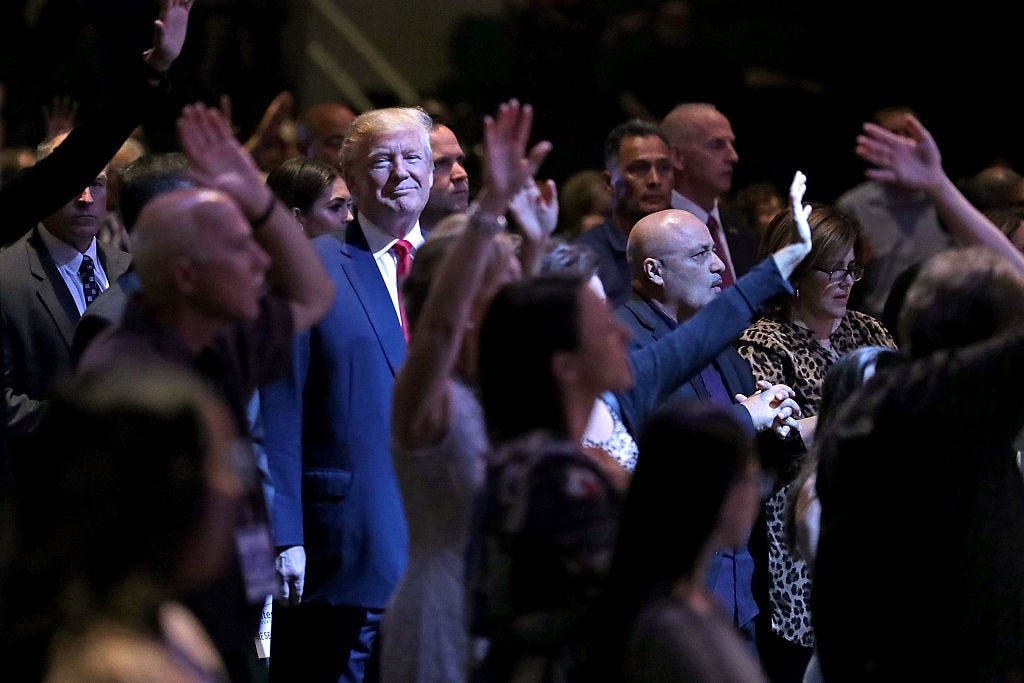
 Rod Dreher @roddreherFounder of Jericho March claims God poked him in the side and woke him up. "God said it's not over." Then God showed him a vision of the Jericho Marches. Then God introduced him to a woman who had the same vision. None of this, you understand, can be questioned. It's revealed.
Rod Dreher @roddreherFounder of Jericho March claims God poked him in the side and woke him up. "God said it's not over." Then God showed him a vision of the Jericho Marches. Then God introduced him to a woman who had the same vision. None of this, you understand, can be questioned. It's revealed.

